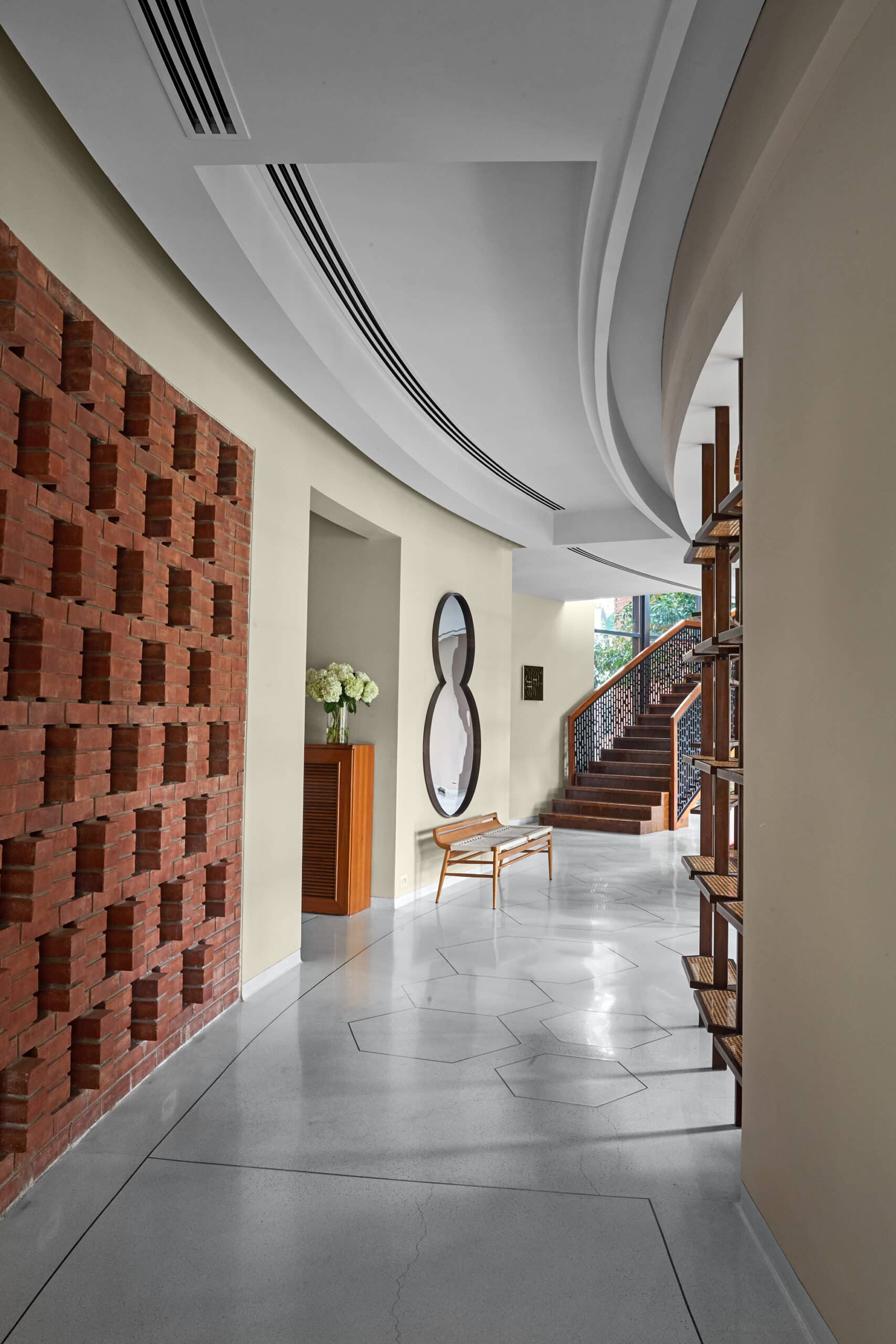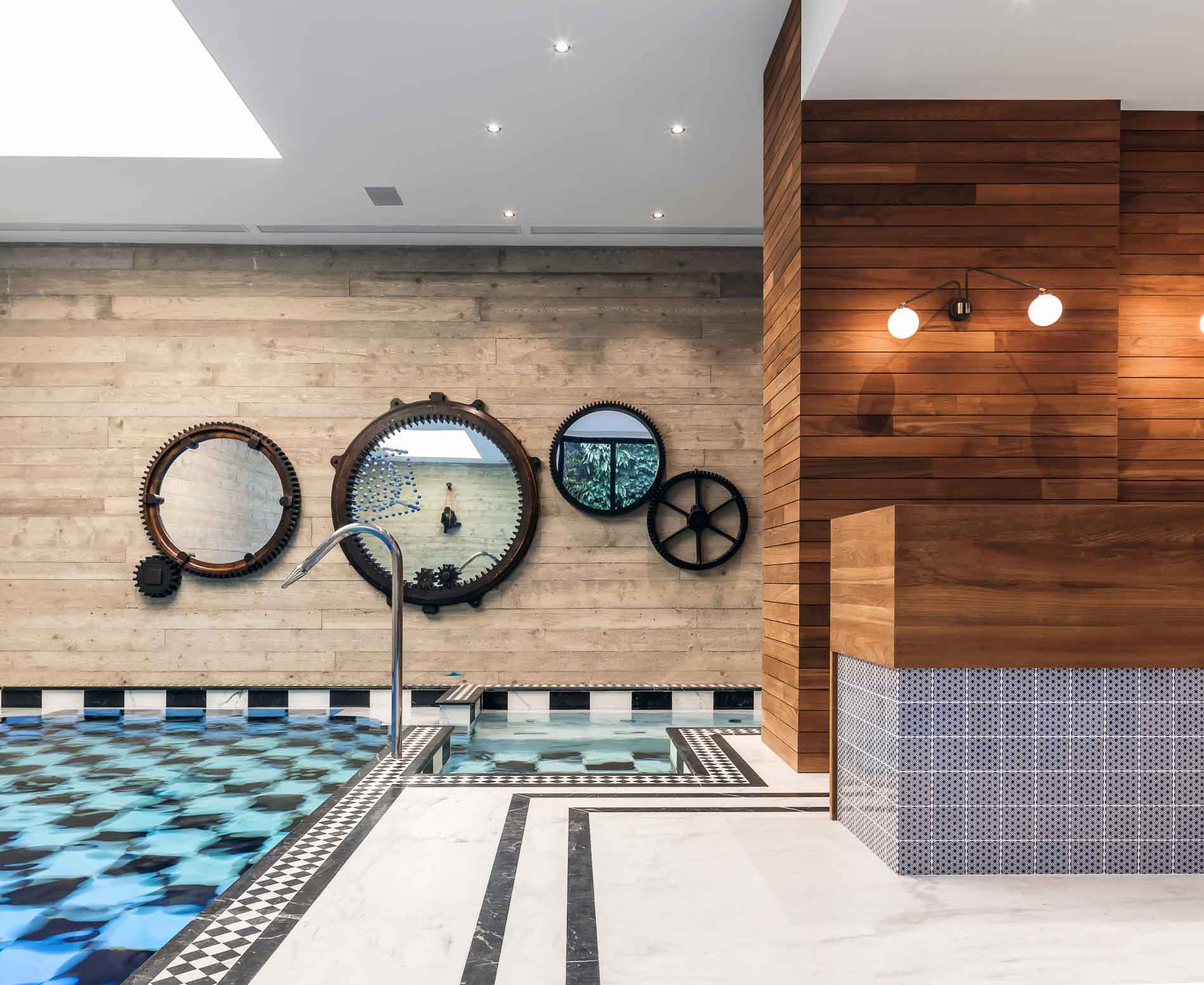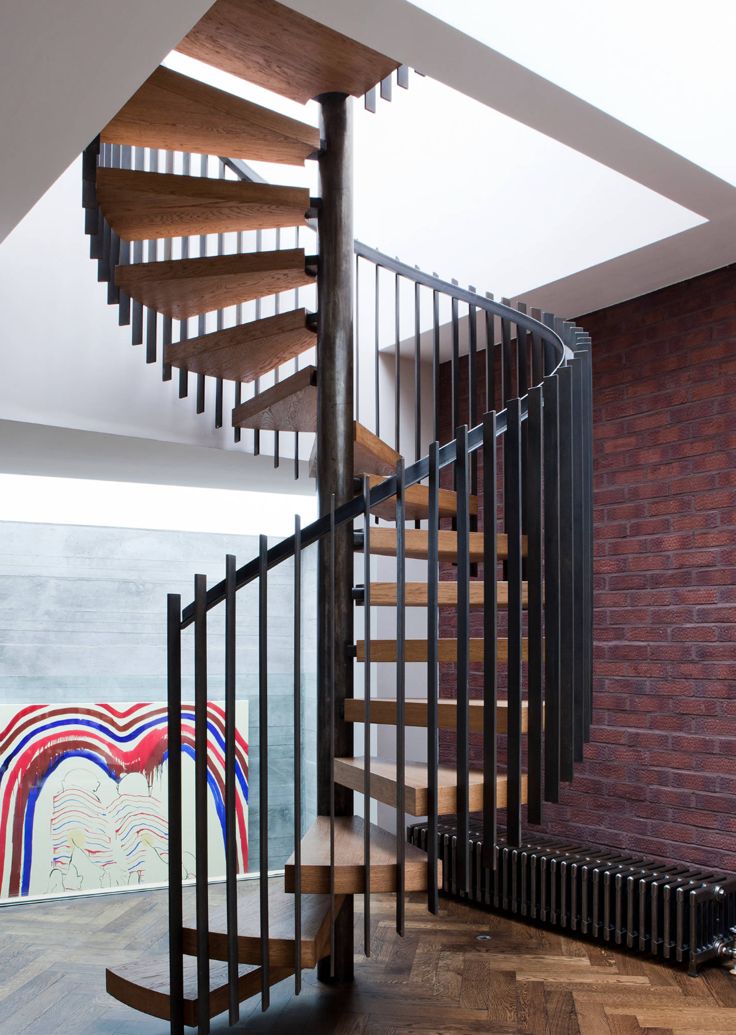Must Have Interior Tech Gadgets?
Technology has changed the way we live and work, so it’s no surprise that it’s becoming an ever-present feature in our homes! Tech gadgets can transform a space both in terms of form and function, but what are the latest innovations, and do you really need them? For the lowdown on the most exciting releases and emerging interior design technology, take a look at our round-up of must-have interior tech gadgets…
Tokenframe 21.5″ NFT Display
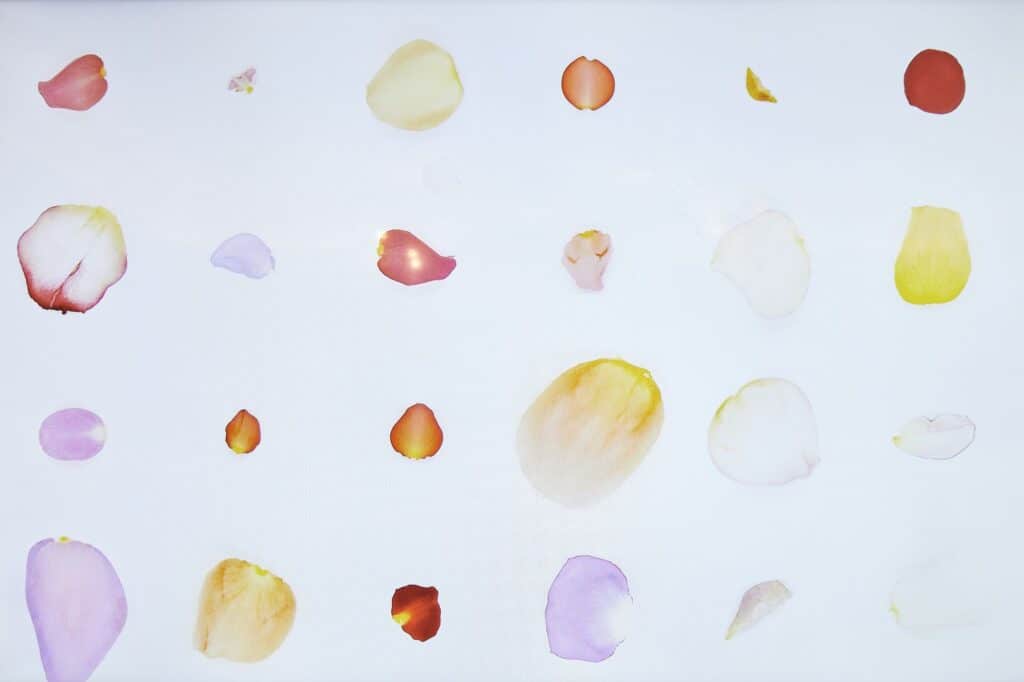
Credit: Sarah Mayohas
Whether you were an early adopter of non-fungible tokens or you’re new to the world of NFTs, the Tokenframe NFT Display is the perfect way to integrate your collection into your environment. Simply cast the NFT from a compatible digital gallery directly to Tokenframe and your art is showcased to perfection. With easy to use in-app or web controls, you can customise slideshows, adjust backgrounds, rotate the display 90°, set energy saving schedules and much more.
Bespoke wooden frames, available in Birch, Black, Mahogany and White, along with crisp, white matte borders complement contemporary design while evoking a timeless style. Whether you want to enjoy your NFT collection at home or in the office, the Tokenframe 21.5” NFT Display is an essential addition to modern interiors.
Elvy Radiation-blocking Phone Charger
If you regularly sleep with your phone by your bed (and most of us do!), the Elvy Radiation-blocking Phone Charger will give you peace of mind, keep you fully powered and even improve your sleep quality. By blocking EMF and EMR radiation and ‘blue light’, the Elvy charger ensures that electromagnetic rays don’t disrupt the Alpha waves your brain produces throughout the night. The result? Fewer distractions, a better night’s sleep and a sleek, stylish accessory to add to your bedside table, dresser or drawers!
Moen Smart Tap
If you’re designing a smart home and you’re a fan of voice control, you’ll love what the Moen Smart Tap can do. As well as voice control, you can control the tap via hand motion or the Moen Smart Water App, which adds another layer of high-end tech to your smart kitchen. Simply tell the smart tap how much water you need, how long to run the tap for and what temperature you’d like and voilà!
While the Moen Tap is undoubtedly Smart, it’s also a stylish addition to any kitchen. With a finish to suit everyone’s taste, you can opt for linear, curved or classic designs in colours including matte black, chrome, stainless steel, brushed gold and black stainless steel to complement your kitchen interior.
Eve Coulisse Smart MotionBlinds
Automated blinds may seem like an early form of interior design technology but the latest collaboration between smart home specialists Eve Systems and Coulisse takes things to a whole new level. The only motors to support Thread and be Matter-ready, MotionBlinds work seamlessly with Apple HomeKit tech without the need for additional support and offer great functionality with other smart assistants, like Alexa and Google Home, too.
What’s more – you can transform roller blinds, venetian blinds, vertical blinds, pleated blinds, honeycomb blinds, roman blinds and even curtains into a smart home feature when you retrofit MotionBlinds technology to existing fixtures. Cable-free and invisible to the eye, they’re a must-have feature for every window!
Herman Miller Sayl Ergonomic Office Chair
As the world of work continues to evolve, being professional no longer means being at the office. Instead, increasing numbers are combining work and home life with flexible arrangements and remote working contracts. While working from home can deliver a whole host of benefits, a lifetime of back pain from hunching over a laptop perched on a coffee table isn’t one of them!
Carving out a work from home workspace is essential and the Herman Miller Sayl Ergonomic Office Chair is the ultimate accessory. Its 3D Intelligent Back and PostureFit sacral support ensure complete comfort, but if that’s not enough to tempt you, its exquisite design will be.
Sayl’s Y-Tower Support and unframed support delivers a ‘striking and visual aesthetic’, while an optional stretch-knit cover or fully upholstered version is ideal when you want to create a warmer, softer feel. Available in a variety of colour combinations, you can add a pop of colour to your office space or opt for a classic feel in a black and grey palette. Whatever style you choose, Say’s smart engineering will make working from home easier than ever.
LG PuriCare AeroTower
The ultimate home air care solution, LG’s PuriCare AeroTower is a must-have accessory for every home. Combining a true HEPA filter and UVnano LED technology, the PuriCare AeroTower removes fine dust, kills bacteria and provides cleaner, purified air wherever its needed.
While you’ll certainly notice the health and well-being benefits that the LG PuriCare AeroTower can offer, you’ll also appreciate its careful design and stylish finish. Its tapered cylindrical shape and soft white colour ensures it fits seamlessly into contemporary interiors. In fact, it’s so well designed that it’s worth having for its appearance alone!
Touch Screen Smart Mirror
Mirrors are a decorative accessory in their own right and are a fantastic way to increase the amount of natural light that illuminates a room. With the Touch Screen Smart Mirror from Capstone Connected, however, you can enhance the functionality of your décor with next-gen technology.
Two settings give you the option to use the Smart Mirror as a tablet or to share your smartphone screen via Thin Cast technology. Access your favourite apps, features, websites and email with hassle-free voice control. Sleek and stylish with minimal framing, the Touch Screen Smart Mirror is available in two sizes: standard and full length. Perfect for hallways, bedrooms, offices and living spaces, this innovative solution is an ideal accent feature and an indispensable addition to your smart home.
AirSoap Air Purifier
A filterless air purifier, AirSoap features washable and reusable collection plates to capture even the tiniest particles of airborne viruses. Combining earth-friendly technology, whisper-quiet functionality and a wide selection of models and styles, AirSoap’s Air Purifier is a great option to enhance the health and well-being of your home and workspace. At just 21 x 10.6 x 10.25 inches, the unit is a subtle yet essential component of modern living and, with white casing, black trims and a discreet AirSoap logo, it’s easy to incorporate this critical piece of kit into any room.
Ultraloq UL300 Multi-Point Smart Door Lock
The latest technology doesn’t just make your home or office more functional and more aesthetically attractive; it can improve security and enhance your safety too. Ultraloq’s Multi-Point Smart Door Lock highlights just how important it is to use the latest advancements to secure, as well as style, your property.
A 6-in-1 keyless entry system allows you to use biometric fingerprint identification, contactless key fob, code, smartphone app, mechanical key or ‘Magic Shake’ to unlock, while an optional Bridge upgrade gives you access to temporary eKeys and codes as well.
While its features and functionality are enough to sell the Ultraloq UL300, its simplicity and style are important factors too. With rounded corners, narrow door mount OLED display and black finish, it adds a contemporary finish to both interior and exterior doors.
Samsung Smart Monitor M8
If your home is filled with devices and you long for more simplicity, the Samsung Smart Monitor M8 is exactly what you’re looking for. Functioning as a Smart TV with SlimFit camera, IoT hub for smart home control and Workspace with in-built productivity apps and remote connectivity to other devices, the M8 Monitor provides all the tech you need in one, slimline design.
Available in Warm White, Sunset Pink, Spring Green and Daylight Blue, you can rely on the M8 to complement your colour palette and elevate your interior design too. The only drawback? You’ll want one for every room!
M-Pwr Smart Door
When you’re planning a redesign or renovation, it’s tempting to focus solely on the interior yet there are exterior elements of any property that have a huge impact on its look and feel. The entryway, front door and/or porch is the first part of your home that guests will notice, for example, and it’s a space that you will pass through multiple times a day, so it’s worth turning it into something special!
With the M-Pwr Smart Door, you can access all the high-tech features you need to maximise security and simplify your routine, but you can choose from a variety of styles, colours and finishes too. Whatever type of property you have, M-Pwr has a door design to match.
Combining a smart lock, video doorbell, emergency battery back-up and motion-sensing LED welcome lights, the M-Pwr Smart Door is a simple and smart way to create a welcoming visual while optimising home security.
Designing a Smart Home
Integrating the latest tech gadgets into your design is a great way to create intuitive interiors that blend form and function for everyday living. By embedding new tech into the design of a space, it becomes an intrinsic part of environment, rather than an afterthought or an ‘add-on’. As a result, you’ll find that the latest interior tech gadgets serve to uplift the design, rather than detract from it, and provide you with a whole lot of creative inspiration.
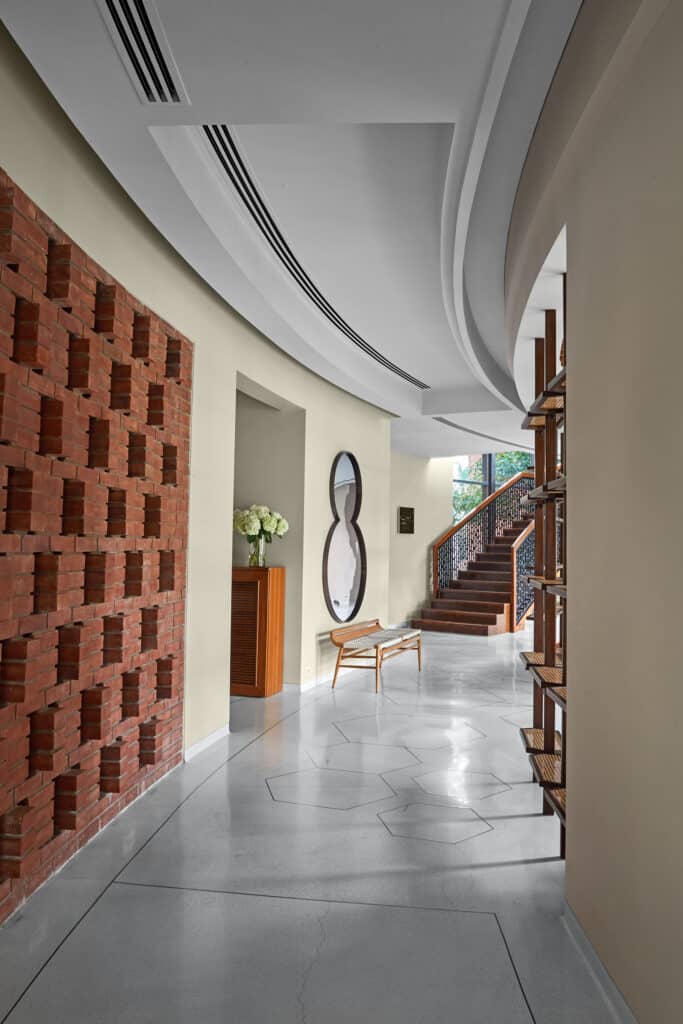
Often defined as a philosophy, concept or simply a way of life, Wabi Sabi is deeply rooted in Japanese culture and can routinely be seen in the country’s art and design. While Wabi Sabi is about much more than simply a beautiful aesthetic, it can be channelled and represented via the surroundings and decor we choose.
By embracing the Wabi Sabi design principle, you can bring elements of this ancient philosophy into your home, workspace and life. In doing so, you’ll find that the natural and ephemeral beauty that surrounds you provides an uplifting, meditative and inspiring backdrop to your day-to-day activities.
What Does Wabi Sabi Mean?
The concept of Wabi Sabi dates back centuries but it can be simply defined as an appreciation of the ‘imperfect, incomplete and transient’. Taking inspiration from Buddhist teachings on the three marks of existence – emptiness, suffering and impermanence – Wabi Sabi encourages us to recognise the beauty in simplicity, authenticity and imperfection.
Taken separately, the terms have distinct meanings. ‘Wabi’ refers to appreciating beauty in simplicity and eschewing materialism in favour of more spiritual rewards, while ‘Sabi’ is concerned with the transient nature of life and the beauty of impermanence.
When taken in conjunction, Wabi Sabi is a powerful and revered concept that can underpin design, aesthetics and, indeed, life. As we integrate the principles of Wabi Sabi into our often fast-paced, stressful lives, we can begin to appreciate the beauty that lies in the imperfect, aged or incomplete.
Wabi Sabi in Design
The concept of Wabi Sabi can be seen throughout Japanese artwork, design and aesthetics and bringing its philosophical elements into your own interior design can help to create an environment that is both visually stimulating and life-enhancing. To learn how to integrate Wabi Sabi design principles into interiors, discover our top tips now:
1. Authentic Colours
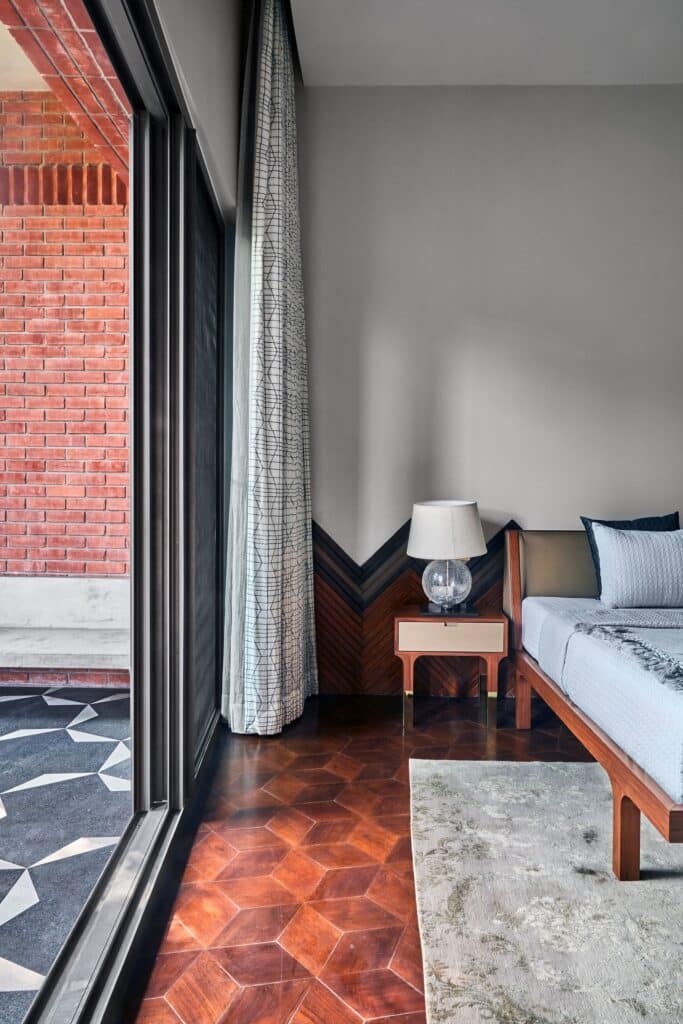
Selecting a colour palette is a key element of interior design, regardless of what type of space you’re renovating or improving. To channel Wabi Sabi in your home or workspace, choose a colour palette that is authentic and earth oriented. Muted, natural tones, such as brown, green, grey, beige and terracotta, can work well when you want to bring Wabi Sabi design principles into your interior as they reflect the inimitable beauty of the natural world, despite its ever-changing and impermanent nature.
2. Asymmetry and Imbalance
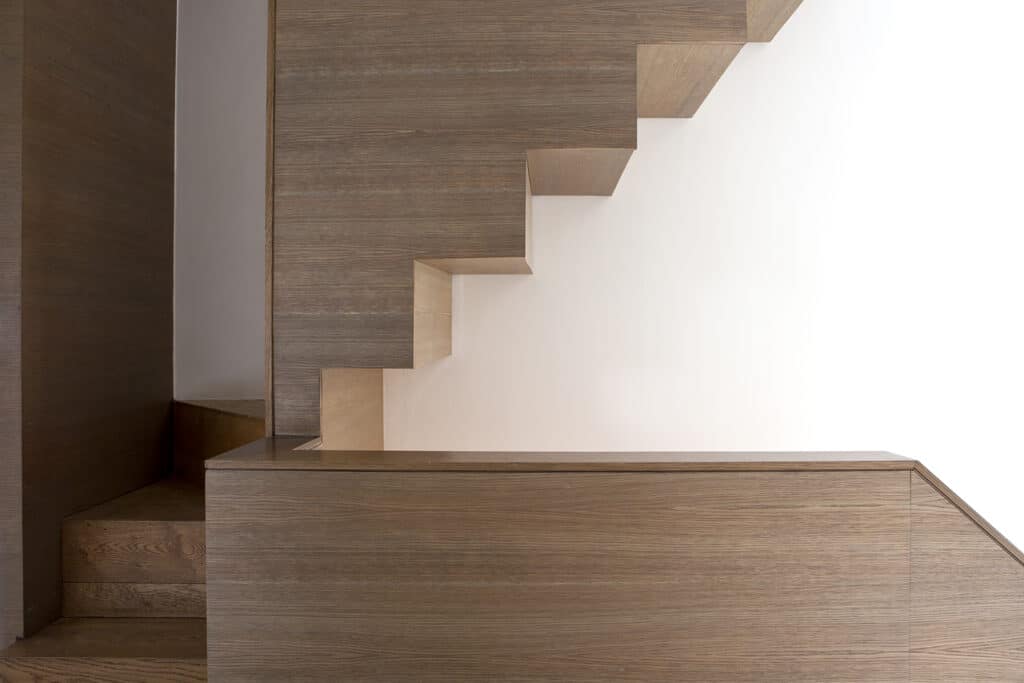
Western interior design principles are often concerned with creating balance via symmetry, but this is not something to replicate when you’re designing a Wabi Sabi inspired space. In contrast, the ancient philosophy celebrates the asymmetrical and the imbalanced, appreciating it for its own unique beauty.
However, Wabi Sabi design is not chaotic or haphazard. While artificial symmetry is not a part of the Wabi Sabi concept, asymmetrical design and styling can deliver its own blend of harmony and tranquillity.
3. Natural Materials
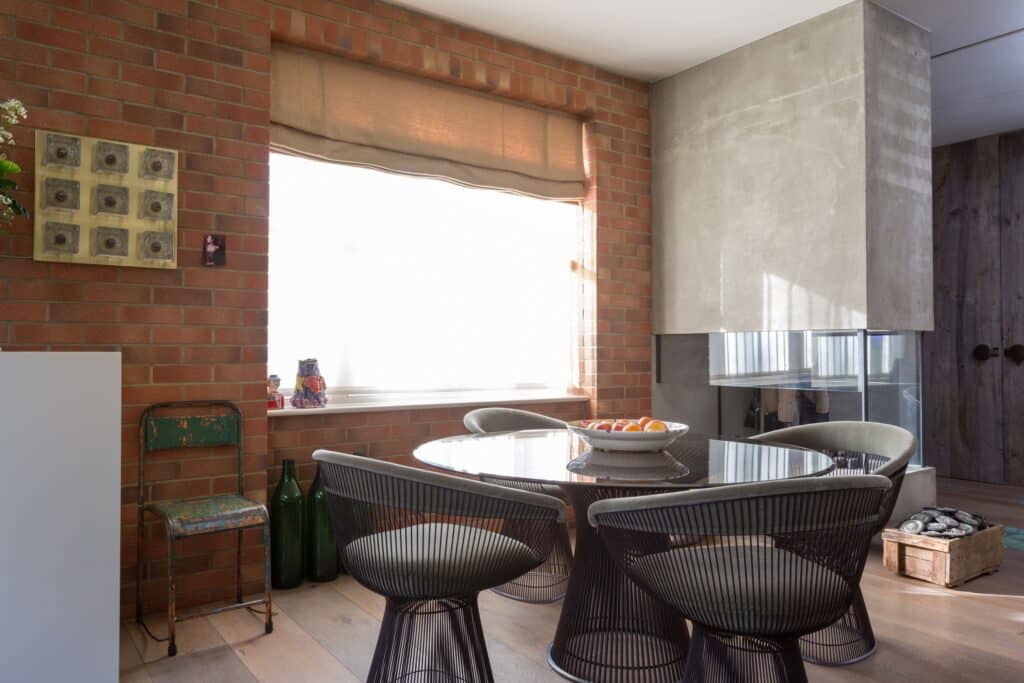
Wabi Sabi philosophy is closely linked to the natural world and can be seen in every element of life. No two trees are the same or match our perceived sense of ‘perfection’, for example, yet this doesn’t diminish their splendour. When you’re developing an interior using Wabi Sabi design principles, be sure to incorporate natural materials in a variety of ways as it’s here that you’ll find pieces that embody Wabi Sabi.
For example, the varying grains in authentic hardwood floors, the knots in a bench made from reclaimed timber or the slight tonal variations in undyed linen cushion covers are the authentic ‘imperfections’ that are central to Wabi Sabi.
In addition to this, integrating natural materials into interior design is known to enhance well-being, which can further the positive impact that a Wabi Sabi inspired space can have. From plants and greenery to jute, stone, bamboo, cork, linen, cotton or clay, there are a variety of natural materials that can help to create a relaxing and grounding space that exemplifies the principles of Wabi Sabi.
4. Organic Shapes
When you’re incorporating Wabi Sabi into interior design, a focus on organic, authentic shapes is beneficial. The artificial shapes and constructs we often see in furniture and decorative accessories represent synthetic perfection that is at odds with the inherent beauty that’s found in nature.
If you’re selecting lighting fixtures, for example, steer clear of styles with rigid lines and clean finishes. Instead, opt for fixtures that are amorphous and distinct. As well as achieving an asymmetrical aesthetic that’s closely linked to the Wabi Sabi philosophy, the space will benefit from pieces that are visually appealing and attention-grabbing.
5. Handmade Furniture and Accessories
Custom, handcrafted furniture and decorative accessories are an excellent choice for a Wabi Sabi inspired interior design. The very nature of handmade pieces ensures they are unique, and their individuality represents so much of what is at the heart of Wabi Sabi. As no two pieces of handcrafted art are exactly the same, you can embrace the differences, asymmetry and ‘imperfections’ and recognise them for the beauty they hold.
6. Reclaimed, Repaired and Recycled Décor
As mentioned above, the principles of Wabi Sabi extend to impermanence and many people believe this to refer to the passage of time. All too often we overlook the intrinsic and external value that time adds to people, places and things in favour of ‘newness’ yet Wabi Sabi reminds us to appreciate the charm and elegance that the passage of time adds to people and objects.
The Japanese art of Kintsugi – ‘golden joinery’ – exemplifies this perfectly, with broken pieces of pottery being put back together with gold lacquer. Rather than attempting to hide the ‘scars’, they are enhanced and showcased to create art that is even more beautiful than in its original form.
By incorporating reclaimed, repaired and recycled furniture, art and decorative accessories into interiors, we can reflect this important element of the philosophy and create a space that reflects Wabi Sabi design principles.
Using Wabi Sabi as Interior Design Inspiration
Although it’s impossible to fully imitate this important and historical part of Japanese culture, we can certainly embrace elements of Wabi Sabi in our design, environment and lifestyles. In doing so, we have the opportunity to learn more about the philosophy, appreciate its value and experience the positive impact it can have on our surroundings, outlook and well-being.
November 22, 2022
The Current And Future Of Wellness In Interior Design
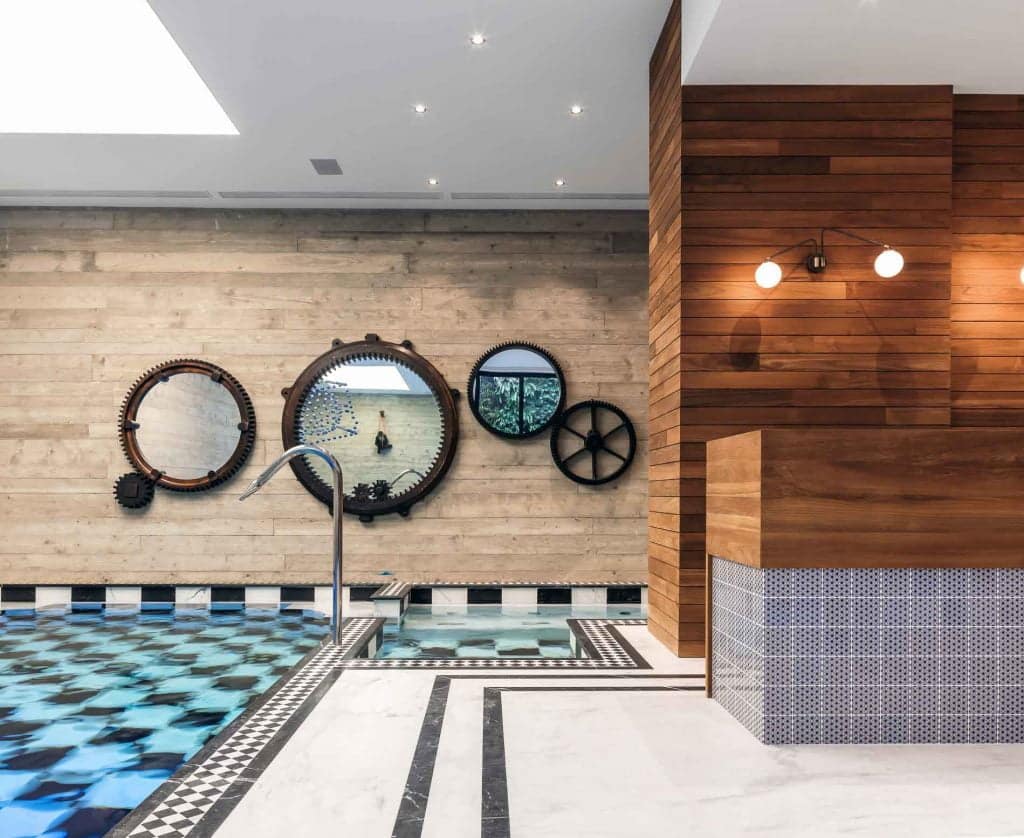
Our surroundings have a huge impact on our mood and behaviour, so it should come as no surprise that they affect our health and well-being. It’s easy to assume that interior design is wholly about aesthetics, but this is far from the truth. In actual fact, good interior design should enable people to elevate their lifestyle, and this includes enhancing wellness.
Whether you’re designing the interior of a workspace or a residential home, incorporating wellness into your design choices improves both the visual appeal and the functionality and feel of the space. To achieve this, take a look at how current and future wellness trends can be integrated into your interior design:
1. Improved Air Quality
Poor air quality can have devastating health consequences, including an increase in respiratory illnesses, strokes and heart disease. While people often associate pollution with outdoor environments, such as busy city streets, indoor air quality should be a top priority too.
When you’re designing a space, consider how the air quality can be optimised. In a full renovation, this may involve integrating more windows or bi-folding doors to provide increased ventilation, for example. Alternatively, you may choose to incorporate next-gen technology in the form of air purifiers to create a healthier environment that promotes wellness.
Of course, you’ll want to avoid polluting the interior as best you can too, which is why low-VOC paint can be a great option. With fewer volatile organic compounds, these paints are less likely to trigger conditions such as asthma and allergies and will pose less of a health risk in the long-term.
2. Designated Workspaces
Today, many people use their homes as a workspace as well as a living environment. While this does have its benefits, it sometimes means that there is little distinction between work, rest and play. As a result, you may notice you feel under increased pressure or show extra signs of stress if you work from home on a regular basis.
To combat this, ensure your interior design integrates designated workspaces if working from home will be a long-term priority. Ideally, you’ll have sufficient space to create a dedicated home office, equipped with all of the essentials you need to navigate your professional life.
Alternatively, consider how a shared space or open plan living area can be artistically segmented to create distinct yet cohesive spaces for work and home life. With more differentiation between these two spheres, inhabitants can relax more easily, reduce stress levels and, as a result, enhance their well-being.
3. Low CO2
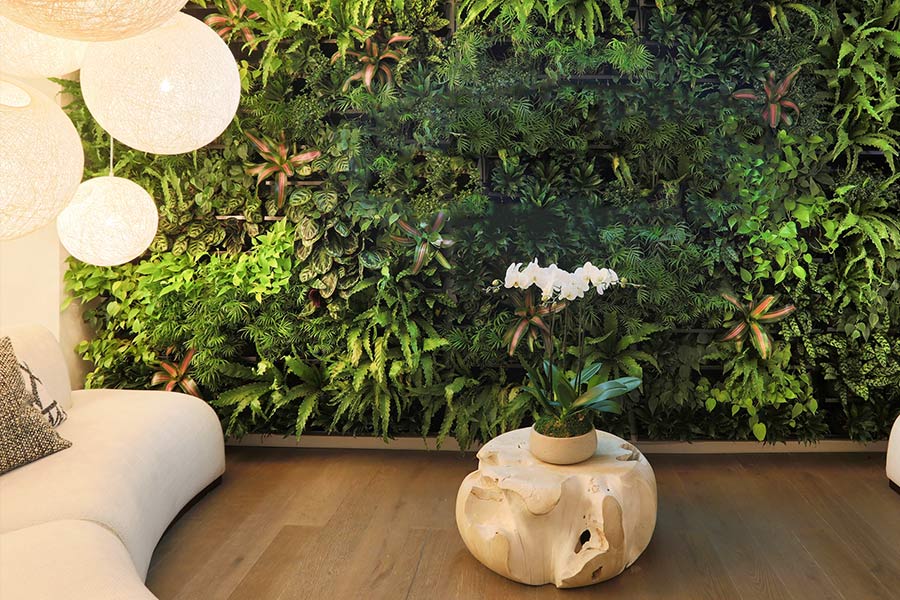
Carbon dioxide, or CO2, can be extremely dangerous in large amounts but even relatively small amounts can have negative health implications. While good ventilation can help to prevent CO2 building up, there are additional ways to keep CO2 levels low within the home or office.
Made from a lime base, CO2 absorbing paints are an emerging option for homeowners, building proprietors and designers who want to make wellness a top priority. As the paint dries, it absorbs CO2 in the atmosphere and continues to improve the surrounding air quality, thus leading to a healthier environment.
Similarly, embracing biophilic interior design styles and featuring lots of greenery in your designs can be an effective way to reduce carbon dioxide levels and promote wellness. Being surrounded by nature has been shown to improve mood, relieve anxiety and reduce blood pressure but plants also absorb CO2 and help to enhance air quality. From single houseplants and miniature trees to interior living walls, there are a variety of ways to ensure nature plays an important role in your interior design.
4. Sound Insulation
Loud noises can damage your hearing, particularly when they occur over a long period of time, but even low-level noise can cause your stress levels to rise. If you’re trying to work or relax, for example, unwanted noise can cause unnecessary disruptions, lower your productivity and increase anxiety.
Fortunately, sound insulation is an easy way to remedy this. With sound-reducing services, such as insulated underlay, you can prevent excessive noise from having a negative impact on well-being. What’s more – the right type of sound insulation can make a design statement in itself! Acoustic wall coatings are available in a variety of colours and their unique shape and consistency ensures they add visual interest and texture to your interiors.
5. Smart Interior Design

Credit: Sarah Mayohas
As technology has evolved, we’ve incorporated gizmos and gadgets into almost every part of our lives. In many ways, however, technology can be used to enhance well-being and smart homes exemplify just how effective this can be. From streamlining and simplifying routines with time-saving tech to promoting relaxation, wellness and healthy activities, smart homes can help people to embrace a healthier lifestyle and mindset.
If you’re planning to redecorate, or you are undertaking a full-scale renovation, incorporate smart technology from the outset and integrate it into your design. This allows devices to be situated in appropriate locations and ensures unwanted fixtures can be hidden but it also ensures that the end-to-end integration and full compatibility can be achieved for optimal performance and maximum wellness benefits.
6. Therapeutic Lighting
Our bodies rely on light to determine their circadian rhythm, which is why short days and dark nights can leave us feeling low. Unsurprisingly, artificial light can disrupt the body’s natural rhythm and therefore negatively impact well-being. When you begin designing a space, use the opportunity to consider the lighting from the outside and determine which forms of therapeutic lighting can best serve the environment and its inhabitants.
Increasing the availability of natural light is always a top priority when designing for wellness but next-gen solutions are an option too. Combining colour therapy with lighting can be a great way to create a calming and restorative space, for example, and many fixtures, fittings and accessories now feature in-built lighting to achieve this.
Designing for Wellness
Successful interior design should serve the space, its purpose and inhabitants and designing for wellness is a sure-fire way to achieve this. By using existing and future design trends to promote well-being, you can create interiors that inspire, fulfil and invigorate people as they embark on their own wellness journey.
Sustainability in Interior Design
Sustainability is a top priority now. From governments and industries to consumers and homeowners, reducing CO2 emissions and protecting the earth is something that should concern us all. But what about your interior design?
Whether you are creating a new workspace or redesigning your home, the sustainability of your surroundings can have a major impact on your health and well-being. What is more – making sustainable choices when curating your designs can reduce the carbon footprint of your properties too.
Let us look at how the interior design world is becoming more sustainable and find out how you can incorporate sustainability into your own interiors:
Recycled and Reclaimed Materials
One of the easiest ways to make your interiors more sustainable is choosing furniture and décor that is crafted from recycled and reclaimed materials. Reclaimed wood is a popular example, with a wide array of furniture and hardwood flooring coming from reclaimed timber. However, you can also pick up other reclaimed materials and fabrics, such as leather, bricks, steel, and glass that require no processing before being refashioned into modern furniture or décor.
Alternatively, products made from recycled materials do require some processing, but this is typically still far more sustainable than purchasing items made from non-recycled counterparts. By making the most of the resources already in the supply chain, we can move closer to a ‘circular economy’, reduce waste and create a more sustainable society.
Remember – choose items that are recyclable too as this will enable you to dispose of them sustainably in the future.
Non-Toxic Paints
A new coat of paint can have a transformative impact on any space, particularly if you opt for a new colour palette or finish. However, paint can have a negative impact on the environment and may even affect your health. Fortunately, new paint technologies enable designers and homeowners to opt for non-toxic versions that are better for everyone.
Standard paint contains volatile organic compounds (VOCs), which contribute to air pollution. If you’ve recently painted a room and noticed an increase in asthma or allergy symptoms, it could be due to the VOCs in the paint you used. By switching to a VOC-free or low-VOC paint, you can improve the quality of your surroundings and create a sustainable interior design that feels as good as it looks.
New innovations, such as lime-based paints that absorb carbon dioxide, even help to purify the air in or around your home or workspace and highlight the potential of enhanced sustainability in interior design.
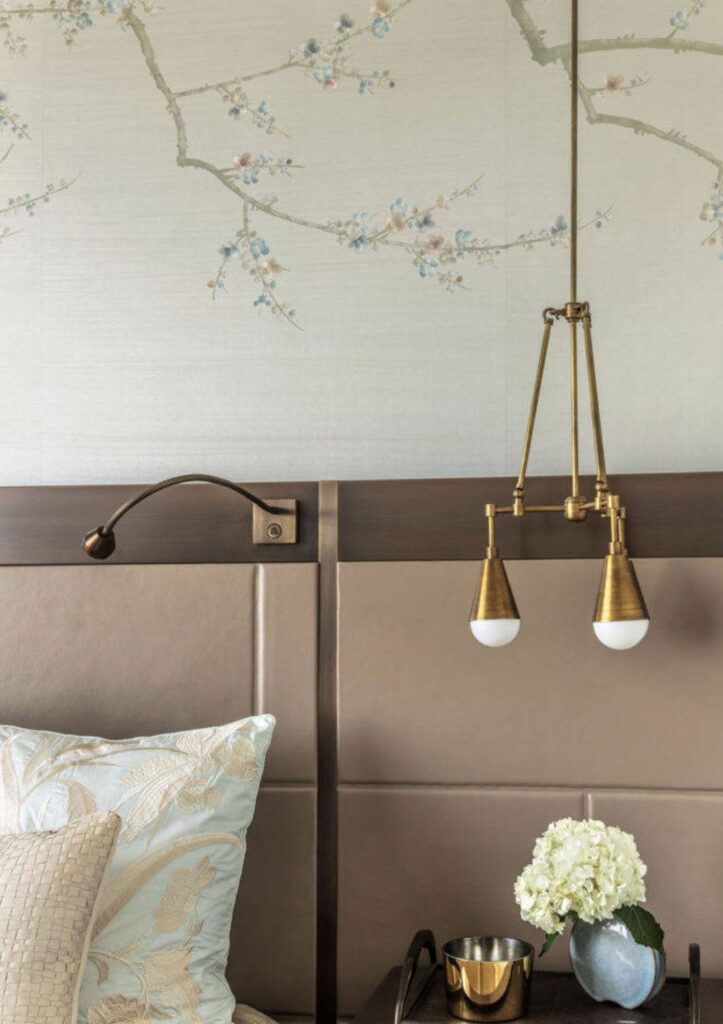
Increased Energy Efficiency
New buildings are typically more energy efficient, but you can always increase the energy efficiency of a space by implementing sustainable interior design. Adding a skylight or choosing sheer drapes over heavy curtains will allow maximum natural light to flow into the room and make you less reliant on artificial light, for example.
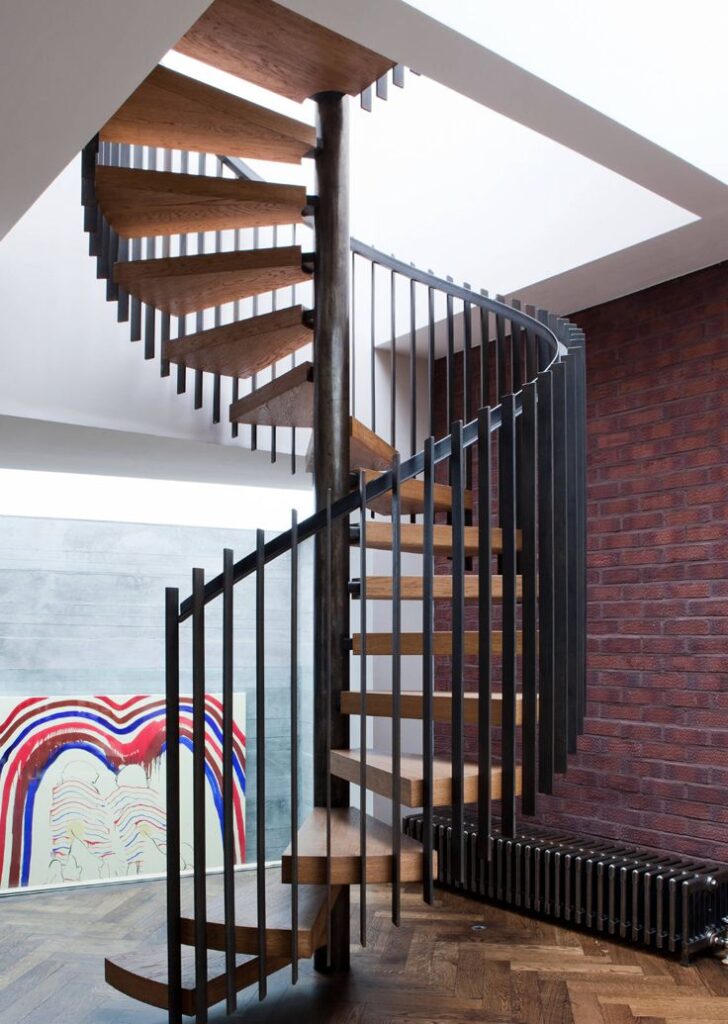
Reducing the carbon footprint of your property is easier than you think, particularly if you incorporate sustainability into your original design plan. Primarily, ensure that the materials you choose are coming from reputable, sustainable designers, craftspeople or companies, and design interiors for optimal efficiency.
If you want to use an array of statement lighting, for example, opt for fixtures made from reclaimed glass and use strategically placed solar panels to provide renewable energy to LED bulbs, rather than relying on incandescent bulbs powered from the mains energy supply.
Living Green Walls
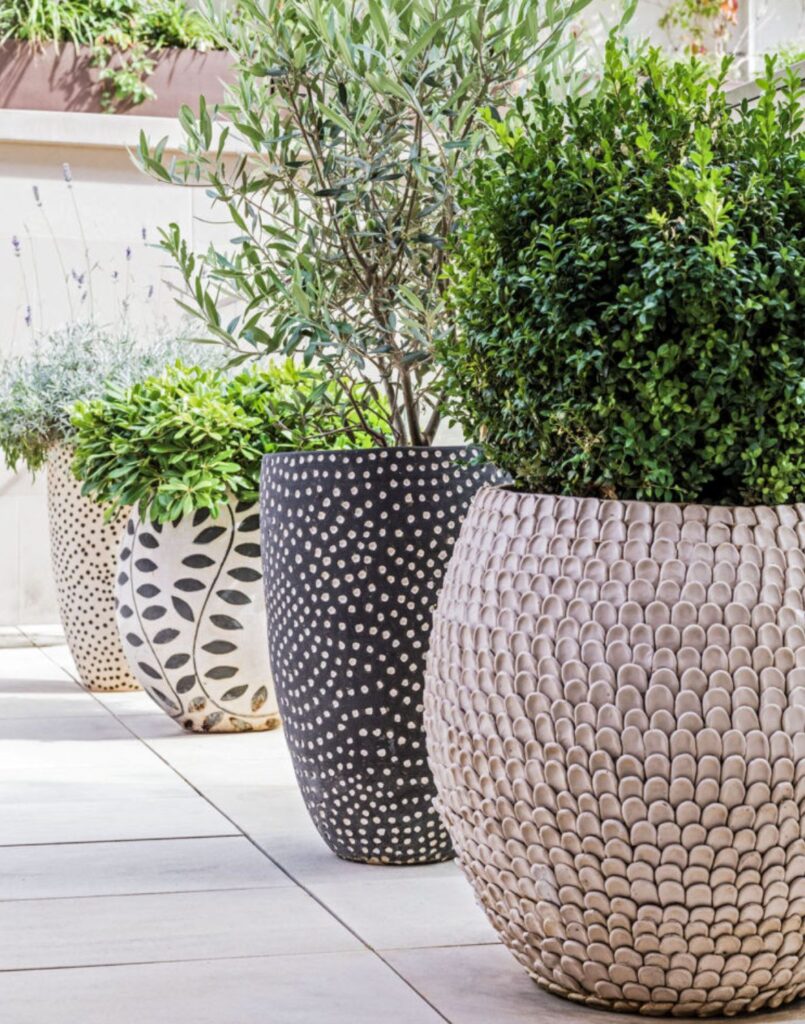
Living walls are a great concept that show how easy it can be to incorporate sustainability in interior design. Each plant ‘wall’ is comprised of smaller components that provide the plants with the nutrient solution they need to flourish. The result? A living, green wall that provides a sustainable, biophilic, nature-inspired interior.
While larger living walls are ideal for workspaces and expansive foyers, smaller options can be an exciting addition to living spaces or dining rooms. As well as being eye-catching and adding visual texture to the space, the presence of greenery and foliage has health-enhancing benefits too. As plants naturally absorb carbon dioxide, they therefore improve air quality. In addition to this, integrating indoor plants into a sustainable interior design has been shown to reduce stress levels, calm anxiety and even boost productivity.
Long-lasting Designs
Trends come and go, which can make it tempting to update your interior design on a regular basis. Of course, choosing a sustainable interior design does not mean you have to eschew the latest styles or miss out on new design trends, but it can mean designing for longevity.
When you plan the next update to your interiors, think long-term and imagine how you want the space to evolve, both in terms of its purpose and its aesthetic. By doing so, you can incorporate this into your current design choices and facilitate a seamless transition. Furthermore, you will be able to choose décor and materials that will stand the test of time and require minimal intervention as your style evolves.
This gives you the flexibility to incorporate the latest interior trends without undertaking a major renovation every year! What is more – selecting sustainable materials and eco-friendly furniture when updating your interiors ensures that you are making choices that will benefit the environment, rather than cause it harm.
Low-Impact Fabric
Fabric is a key component of interior design. Whether you are selecting window treatments, sofas and chairs, area rugs or bedding, the fabrics you choose will have a significant impact on the overall aesthetic. However, some fabrics are more sustainable than others, which is why it is important to take this into account when designing an interior.
Sheep’s wool is a renewable resource that requires limited processing, for example, while hemp produces three times more fibre than cotton but uses half the amount of water in its growth phase. Similarly, felt is typically a low-impact fabric that is biodegradable, and jute is a hardwearing fibre that absorbs carbon dioxide and emits oxygen.
Create a Sustainable Interior Design
Committing to sustainability in interior design needn’t limit your design choices or prevent you from embracing any style you choose. Instead, turning your mind towards sustainable materials and fabrics may even help you to discover previously overlooked options that will enhance your interiors. With a variety of options, including newly created innovations and traditional organic materials, creating sublime, sustainable interior designs can be easier and more exciting than you realise.
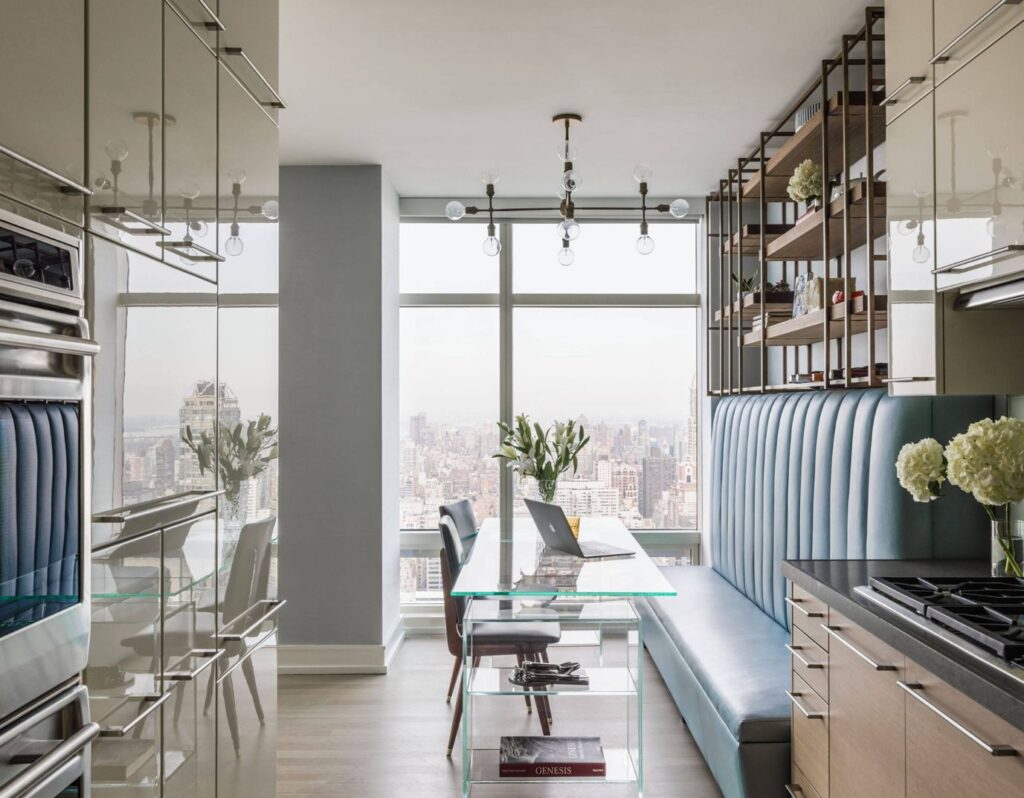
Autumn Interior Design Trends 2022
As we bid farewell to the last of the summer sun, it’s time to embrace the cooler temperatures, warmer hues and blustery winds that are synonymous with autumn. From the crackling of a bonfire to the crisp leaves underfoot, autumn evokes a sense of a warmth and unity, even when the days are cooler, and the nights are drawing in.
If you’ve been planning to refresh your interior design, now is the perfect time to forge ahead with your plans. As a transitional season, autumn changes can take you from summer straight through to winter and ensure that your interiors remain in style all year round. For inspiration, take a look at these top autumn interior design trends for 2022:
Farmhouse Style
If there’s one autumn interior design trend to follow this year, it’s farmhouse interiors. If you’ve always assumed that farmhouse style is traditional, outdated or cluttered, think again. Modern farmhouse interiors evoke the same sense of warmth of comfort but strike a balance between modern minimalism and rustic living with elements of Scandinavian design.
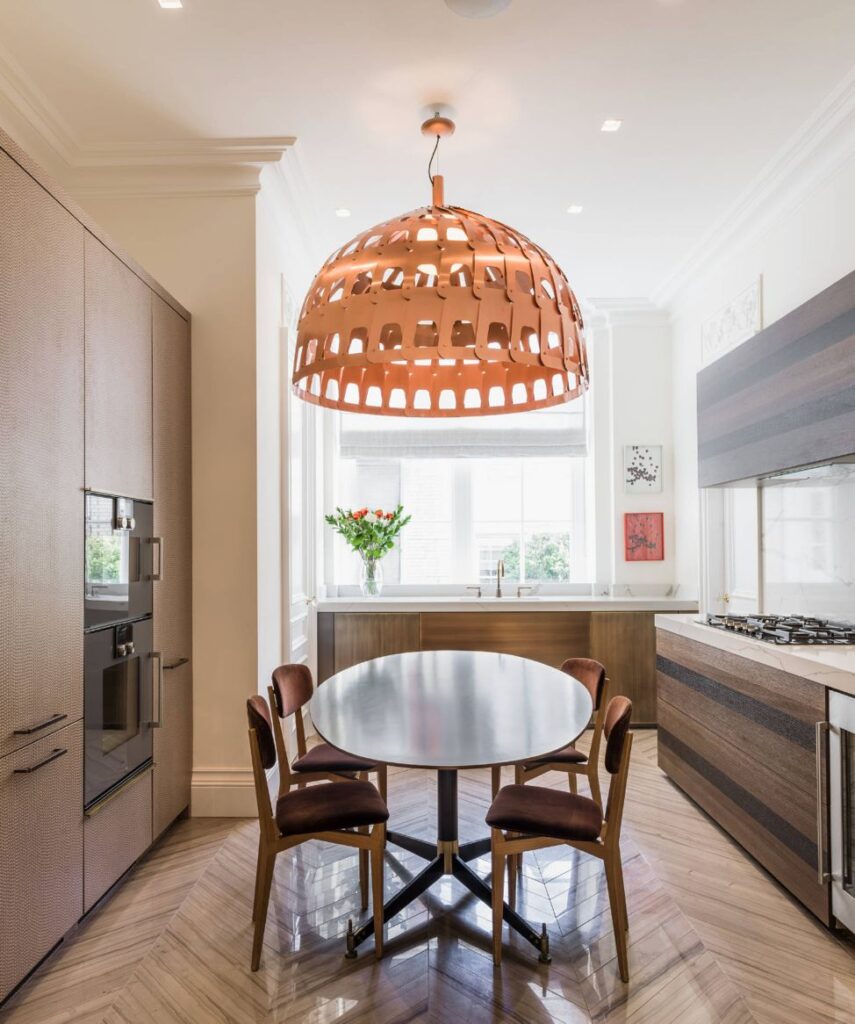
Neutral colour palettes with white, beige or grey are a popular option in farmhouse interiors, but accent colours can add a brighter and more vibrant feel to your autumnal interior design. Wide-plank hardwood floors along with shiplap cladding or natural brick walls are also popular farmhouse features and they’re easy to integrate into modern homes.
While farmhouse interior design is often associated with kitchens, this isn’t the only room that can benefit from a modern rustic makeover. Perfect for living spaces and bedrooms, farmhouse interiors can be a fantastic way to make your space feel more welcoming this autumn.
Warm Colours
While cooler tones work well in summer, richer, warmer tones are perfect for autumn interior design. As it gets colder outside, you can make your interiors feel inviting and cosy by choosing a warm colour palette.
Burnt orange, terracotta, moss green, mustard yellow and deep rust are all popular autumn shades that can offer depth and will easily create a nurturing, cocoon-like feel. Pair darker hues with lighter shades, like light apricot, tawny brown, coral or light olive for a cohesive palette that will lift and soothe throughout the season.
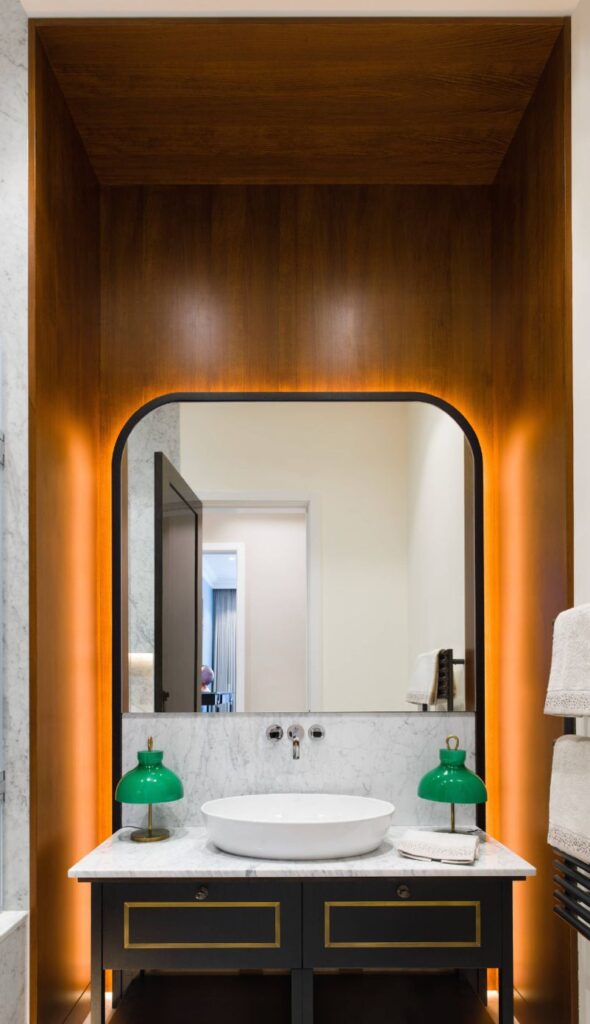
Seasonal, Nature-Inspired Interiors
As we move into autumn and winter, you needn’t miss out on the great outdoors. In fact, nature-inspired interiors are a top autumn interior design trend this year and it’s a great way to make your home or workspace feel fresh and invigorating.
A colour palette featuring neutral and natural autumnal hues, such as cream, sand, sage green, dusky blue or buttermilk can be a stylish way to integrate the nature-inspired interior trend into your latest designs, for example. Using natural materials, like stone, wood and bamboo, in your interior design is also a super-effective way to bring a nature-inspired interior to life.
Additionally, create seasonal accents with natural or faux foliage to elevate your autumnal interior design. Dahlias and hydrangeas in earthy tones are ideal for autumn-inspired tablescapes, while fallen leaves, conkers and berries can be weaved into garlands or wreathes to add an autumn fall via transitional décor.
Textures and Layers
Adding texture to a room enhances its aesthetic but it also changes the way the space feels. With a range of textures, for example, a room can feel more welcoming and cosier, which is exactly what you’re aiming for with the latest autumn interior design trends. To make living areas feel more in-keeping with the season, try adding a woollen area rug, cashmere throws and boucle cushions to add texture and visual interest.
Similarly, use layers to give a room an autumnal update and incorporate the latest styles. Sheer drapes will allow you to make the most of the natural light before the shorter days arrive, for example, while fresh wall art adds another element of visual interest.
As well as enhancing the space, incorporating more textures and layers is also an easy way to revamp your home or workspace for autumn. With minimal effort required, you can change the entire feel of a property simply by modifying the textures and layers that are currently present.
Atmospheric Lighting
Updating the lighting in any space can have a transformative effect, particularly when you’re going to be more reliant on faux lighting in the autumn and winter months. Choose floor lamps and table lamps in materials and shades that complement your chosen colour palette or use warm metallics to lift the space.
Of course, statement lighting can be a great way to make an impact too, so don’t hesitate to update your main fixtures and fittings. Drop lighting is ideal for high ceilings or larger spaces, while recessed ceiling lights and wall lights can add cosiness to living spaces and bedrooms. If you want to make a room feel more inviting and soothing, opt for bulbs that emit a warm glow, as opposed to cool white bulbs that are better suited to brighter spaces and working environments.
Maximalist Interiors
If you’re ready to move away from the minimalist feel that has long been associated with contemporary interiors, you’ll love the maximalist feel that’s a top autumn interior design trend this year.
Maximalist design works on the premise that ‘more is more’ – but stop short of cramming as much into a room as possible! Instead, you’ll want to strike a balance between colours, textures and patterns to ensure the space doesn’t feel overwhelming or cluttered.
Bold patterned wallpaper can be an effective way to ease into a maximalist interior design style, for example, while plush carpets or mosaic tiles can complete the effect. A maximalist design should stimulate the senses, so opt for multiple textures and layers. If you’re worried that a maximalist interior may look haphazard or chaotic, don’t be. Repetitive designs can embody the maximalist mantra while retaining a sense of order and symmetry.
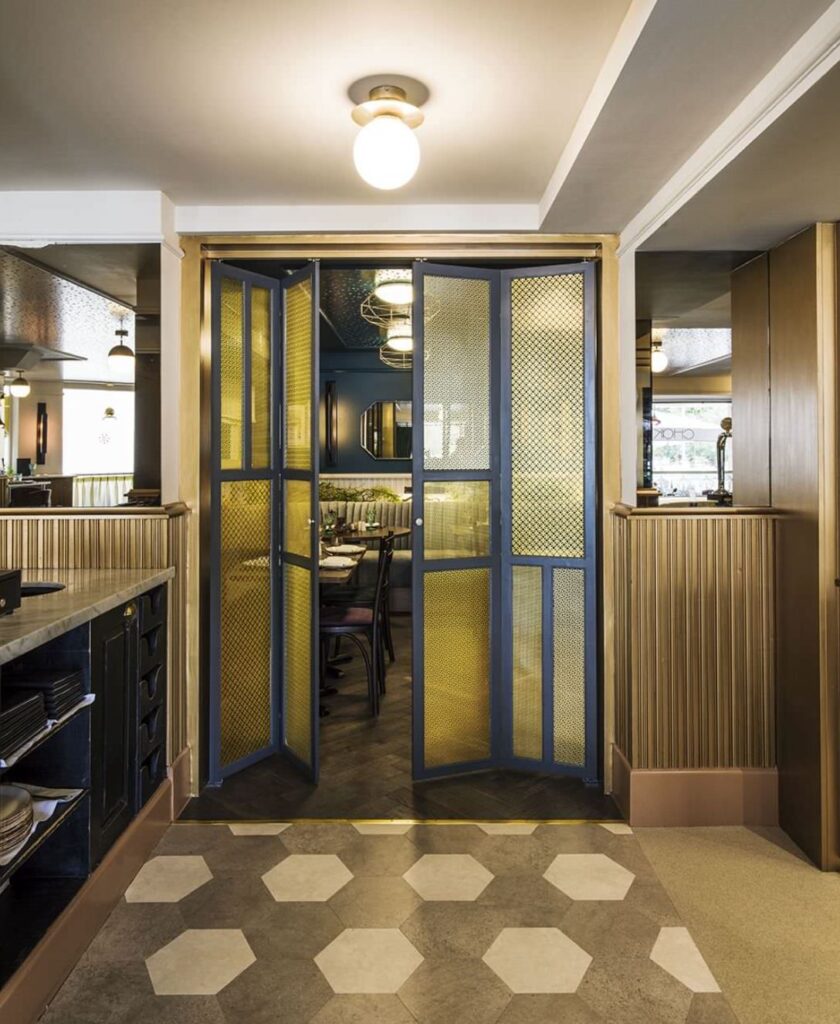
Make the Most of Autumn Interior Design Trends
With the season already upon us, there’s no time to lose if you want to make the most of this year’s autumn interior design trends. From major renovations to subtle upgrades, there are endless ways you can incorporate new and emerging styles to give your space an autumnal feel.
Greek Style Interior Design Trends
The home of Western philosophy, the Olympics and spectacular architecture, Greece has had a major influence over how the world has developed. It should come as no surprise then, that Greek interior design has influenced architects, designers and landowners for centuries.
Whether you’re creating a modern idyll or a classical environment, incorporating Greek style interior design can elevate the aesthetic and create a cool yet welcoming feel. Read on to discover the top Greek style interior design trends and find out how to incorporate them into your own properties:
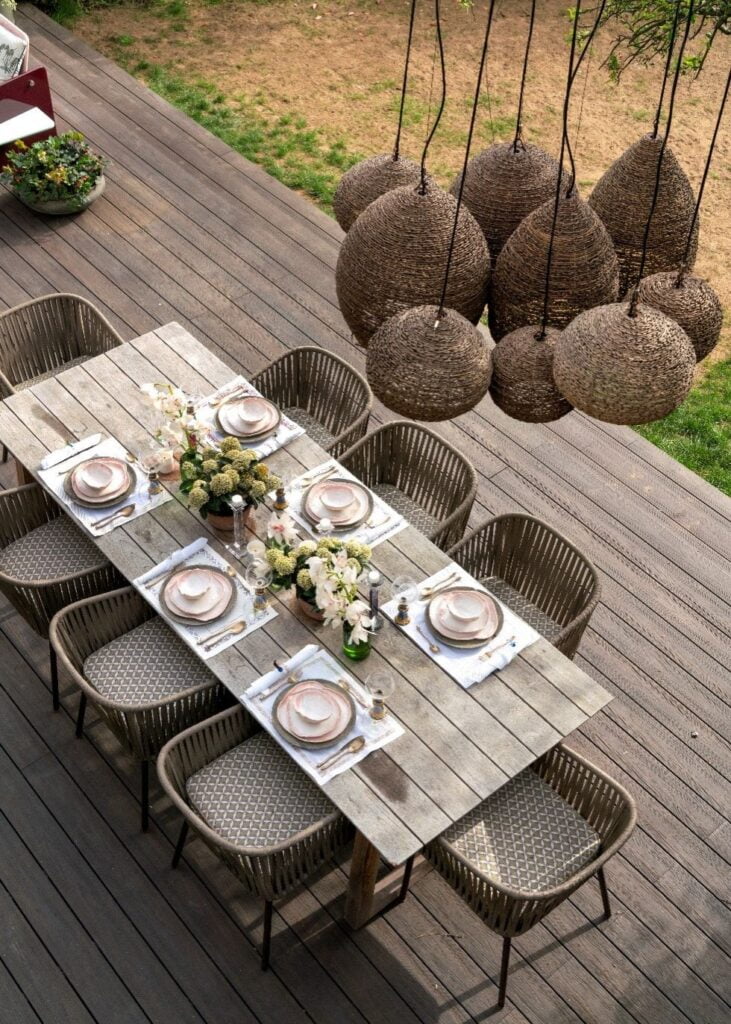
High Ceilings and Columns
If you’re designing a new home or renovating a property, take the opportunity to integrate high ceilings into your plans. Extra vertical height will add an expansive feel to any room and is reminiscent of the high ceilings seen in buildings throughout Greece.
Similarly, interior columns are a sure-fire way to embrace Greek interior design and give the space an unmistakeable Mediterranean feel. The simplest style, Doric, are wider at the base than the top and feature limited decoration, which can make them a great addition to today’s contemporary interiors.
If you want to enjoy classical Greek décor, opt for Ionic columns, which have scrolls on either side at the top of the column, or Corinthian columns, which incorporate scrolls and leaves from the acanthus plant as decorative adornments.
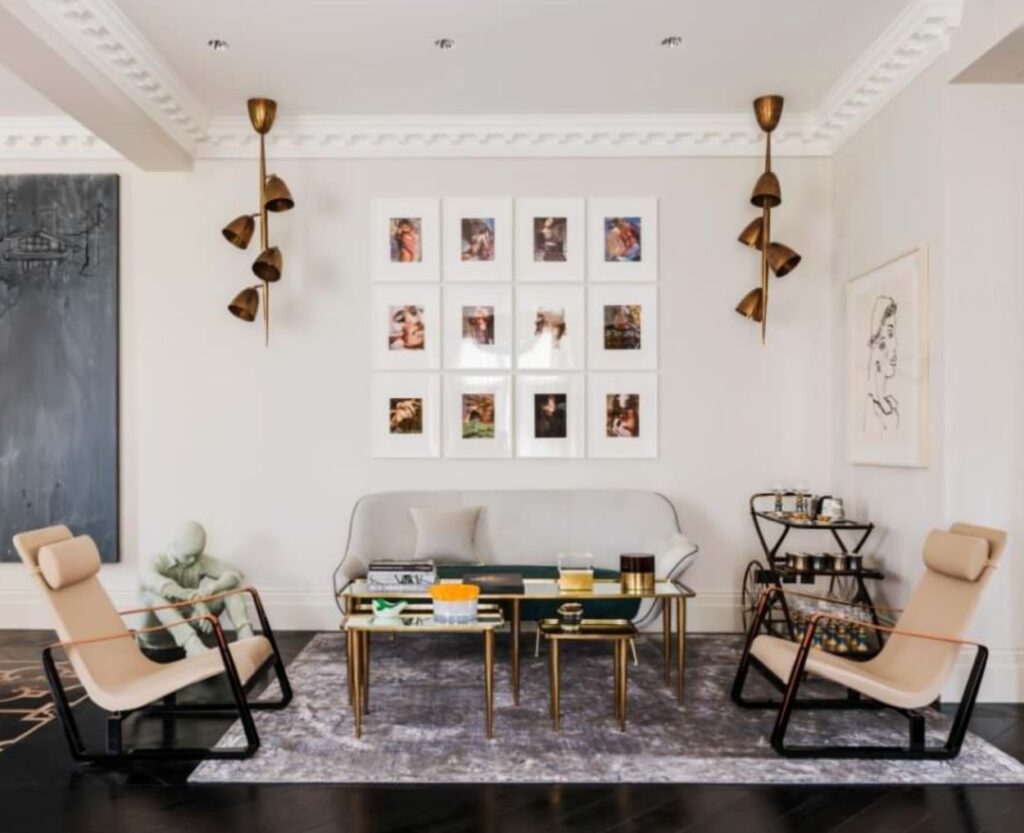
Rich Colour Palette
When you think of Greek style interior design, clean white and shades of blue probably spring to mind. While this colour palette is certainly still en vogue, don’t feel that it’s the only way to use Greek style interior design trends in your home or workplace.
Traditionally, Greek interior design has always made maximum use of the natural light that was available, so aim to imitate the sun-drenched style seen on the Greek islands. Rich shades, such as olive and terracotta, are truly authentic, but be sure to weave gold and metallics into the palette to lift the overall aesthetic and add a touch of glamour to your interiors.
For a contemporary twist, use blacks, browns or greys to contrast white and gold. This adds a dramatic feel to the space and utilises the brightness and decadence of gold hues to lift the space, add visual interest and deliver contrast.
Sculptures and Décor
Influenced by Egyptian and Near Eastern art way back in 800 to 300 BCE, Greek sculpture revolutionised the artform and created a genre of sculpture that is still widely emulated to this day. While genuine ancient Greek sculptures still remain, you’ll find that many modern artisans and craftspeople incorporate Greek styles into their own work.
With so many options to choose from, you’ll find Greek inspired sculptures to suit every space and décor. From life-size, life-like models of the human form to ‘relief panels’ that blend sculpture with the background, there are endless ways to integrate this epic Greek interior design trend into your own style.
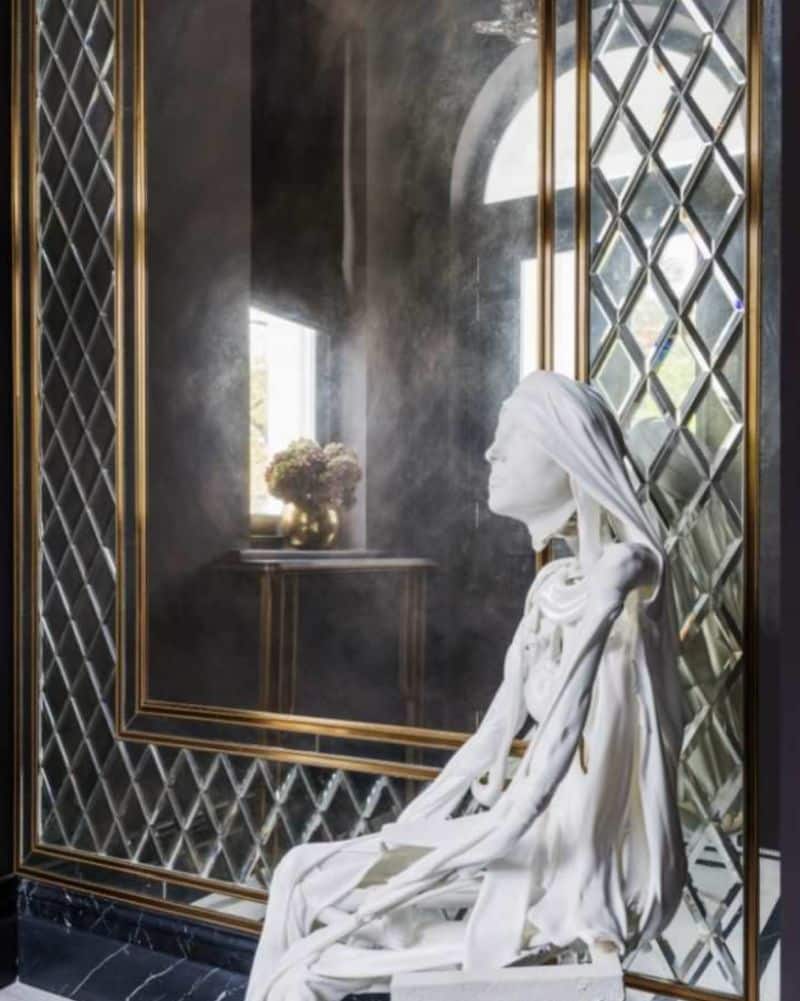
Remember – decorative pieces should never be an afterthought in interior design. Architectural sculptures, such as perirrhanteria, friezes and pediments, have always been a popular feature in Greek style interior design and you can use these in your own space when you make them an integral part of your interior design.
Mosaics and Patterns
Mosaics are frequently used in Greek interior design, and they are still an excellent way to give an interior a Hellenic feel. Tiled mosaic flooring is ideal for Greek styled kitchens, bathrooms, hallways and foyers, for example.
Alternatively, integrate tiled mosaics as a decorative wall feature to add visual interest to the space and emulate this classical Greek interior design style. While traditional mosaics are typically created from stone, ceramic and glass, modern designers use a wide range of materials to add a contemporary twist to this eponymous style. Marble, porcelain and even recycled plastics can all be used to create vibrant and intriguing or soothing and relaxing mosaics that will complement your preferred interior design style.
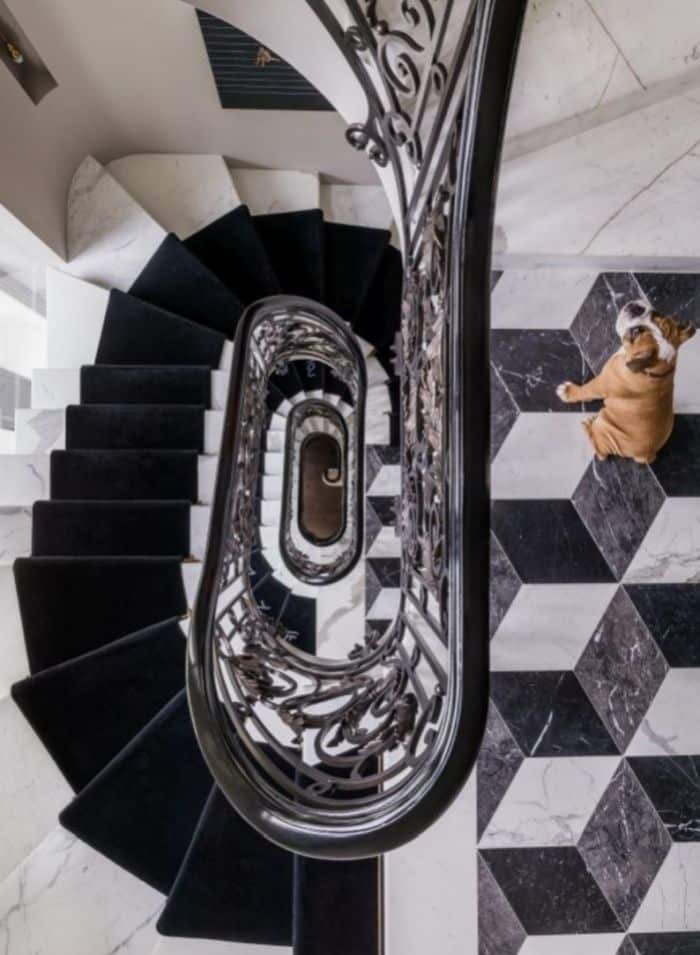
Lighting Design
Lighting is always a key concept in interior design, and it is certainly a critical component when it comes to Greek style interior design. Natural light was used to lift interiors, with window shutters traditionally being thrown open to allow the sunlight to cascade into a room. Of course, you can’t always rely on a splash of Mediterranean sun to achieve this effect, but you can use striking lighting design to add the finishing touches to Greek interior design.
If you’re using metallics such as gold or bronze in your colour palette, why not select eye-catching light fixtures in these accent materials? Similarly, if a space has high ceilings to create a feeling of extra space, drop lighting can create a warm and nurturing feel that prevents the room from feeling overly spacious.
Materials and Patterns
Unsurprisingly, local temperatures had a major impact on the types of materials seen in Greek interior design. Natural materials, like cotton, linen and bamboo, were most effective at keeping the space cool, so you’ll often see these in traditional interior designs. While these are certainly a great option in a modern Greek style interior design, you needn’t feel limited when it comes to selecting materials. Richer and warmer fibres, such as velvet, can be a great option for modern Greek-inspired styles and statement pieces featuring these materials will add warmth to any room.
If you’re opting for patterned styles, remember to choose motifs that have a vertical orientation. These were used in Greek interior design to reflect the vertical space, high ceilings and decorative columns, and they are a highly effective way to incorporate the subtle elements of Greek interior design into the home.
Embracing Greek Interior Design
Greek style interior design continues to provide inspiration for today’s designers, artisans and homeowners, so you’ll find plenty of ways to bring this style to life when you’re working on your own interiors. With a range of elements to choose from, Greek interior design finds a way to make the most of any space and makes its easy to create an inviting, luxurious and relaxing aesthetic that draws you in.
Detox And Declutter Your Home
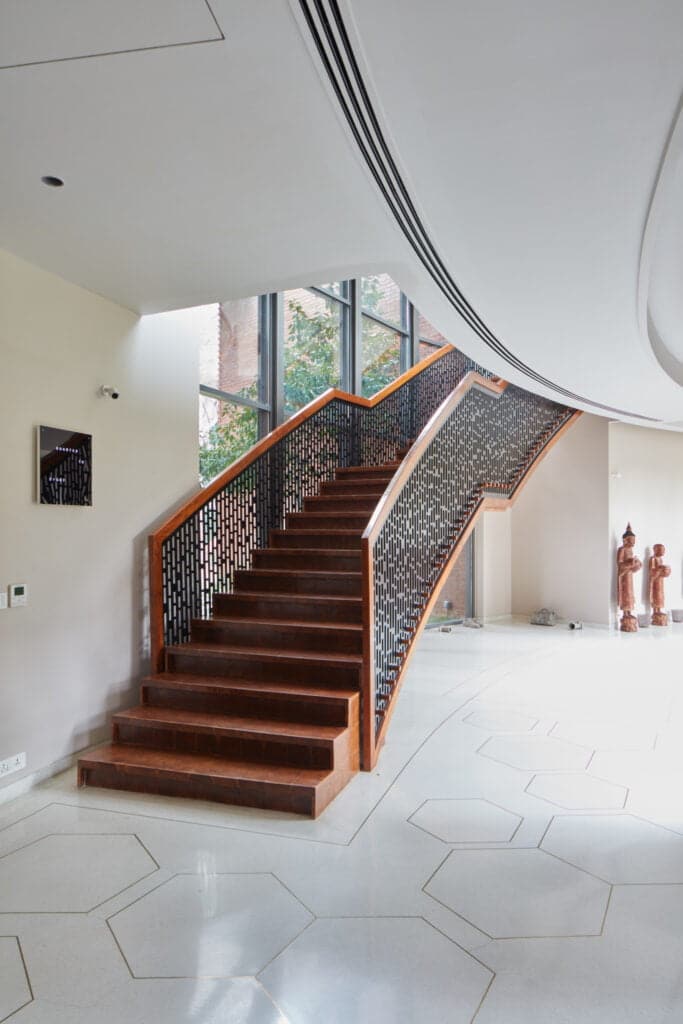
Studies have shown that people who accumulate clutter in their homes share certain traits, ways of thinking, and behaviours. For example, they are perfectionists, lack time management skills, struggle to focus on the present, and need to be needed. By understanding why you hoard possessions, it will be easier to make a positive change. But do not despair as we look at strategies for decluttering the home. Secondly, we discuss why it is necessary to detox after you declutter, and how to do so.
Why Declutter?
Our homes are an expression of ourselves. As such, we want them to reflect harmony and beauty and a state of calm. Clutter detracts from the ambience we want to experience when we return home after a long day at work. Our homes are our castles.
Another reason to declutter is that we want to express our style through our décor. Having chosen beautiful pieces with which to furnish our homes, we want to showcase the aesthetics of that style at its best.
Additionally, we want to surround our furniture with space so that we can move with ease as we enjoy our homes.
A Minimalist Approach
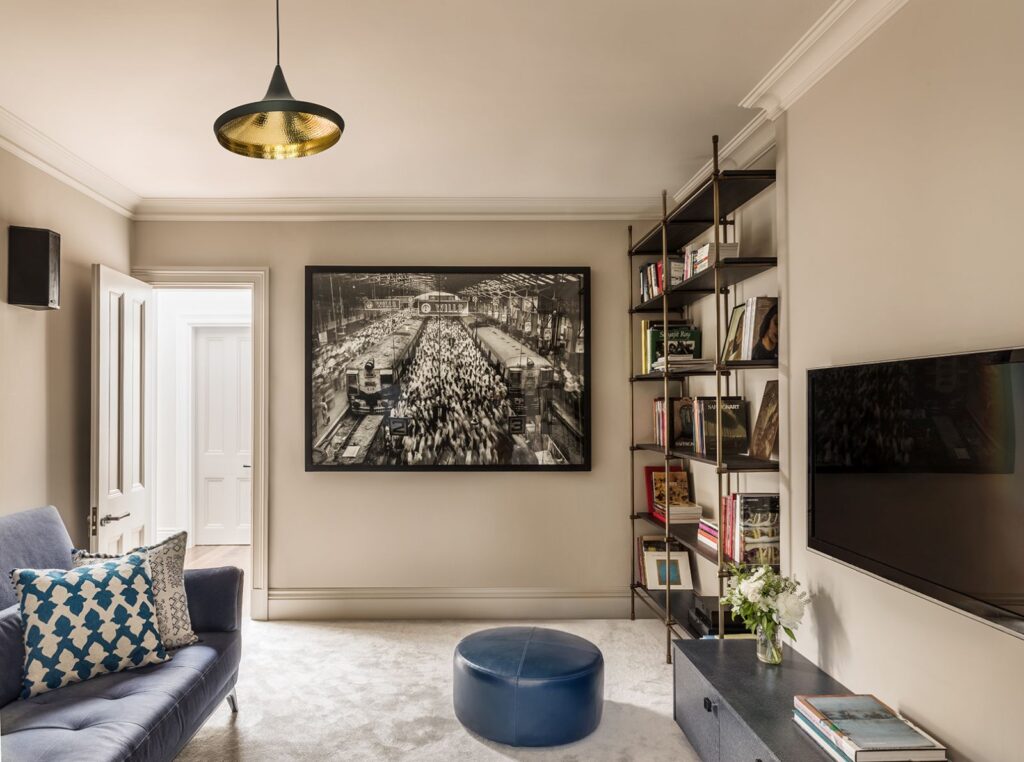
The minimalist approach relies on having few pieces of furniture but making those stand out. To avoid clutter, one should not purchase too many items as they will get lost in the whole rather than being individually visible and able to make a potent statement of sophistication and elegance. Then our really special pieces of furniture that were so carefully chosen can shine forth and be truly appreciated.
If you find that your home has become cluttered by too much furniture, it is time to go back to the drawing board and carefully consider what your chosen style is. Ask yourself, which pieces of furniture are true to that vision? How can they be positioned for maximum impact, style, and comfort? Which items of furniture have strayed from the original concept? Has your vision changed at all and how best can the newer one be realised? Have you purchased something that you truly love but that does not fit in with the rest? Is there another place where it is better suited? For example, you can repurpose heavier coffee tables for the bedroom as bedside tables and replace them in the living room with minimalist tables with sleek lines.
A minimalist design will always allow your furniture to be seen at its best provided you have not crowded too many items into a space too small to contain them. You may have to make a few hard decisions but in the end, it will be worth it. It will free your mind from stress and provide a harmonious living space where you enjoy spending time and can invite your friends to.
Colours, Shades, And Tones
Avoid saturating the indoor rooms with an overwhelming mix of colours. Furniture pieces in neutral colours are more versatile and enhance the aesthetics of a room. The right colour palette integrates all the elements of walls, furniture, and accessories. This has a positive influence on mood and provides a restful space.
Bedrooms benefit from wooden beds and bedside trays that place everything close by and make them accessible. Wood can be functional or elegant and a combination of the two lends itself well to the minimalist look you want to achieve. It is a restful medium that will not jar with soft blue walls and the greenery of pot plants. Then, when you enter the room, immediately your spirit is soothed, and you start to unwind and are restored.
Look For Add-ons
If you have the option, select furniture that can be self-assembled without tools and employ basic Do It Yourself (DIY). These pieces allow you to remake the living space with minimal fuss and you can attach or detach parts to reassemble them in new ways. This is great if you are moving homes where the sizes of the old and new rooms are different, but you are keen to keep your existing furniture. Thus, you can optimise the layout and ensure that the space and the objects within it are perfectly balanced and soothing.
Reduce Items That Need To Be Stored
You can declutter your home further by finding solutions for different scenarios. For example, a trans-seasonal comforter is suitable all year round. This beats having to change your bedroom décor from one season to the next. It also eliminates the need to store bedding for seasonal changes in the weather. A bonus is that your comforter will be irresistible when it is time to let go of the day and its stresses and have a night of restorative sleep.
Decluttering Your Home
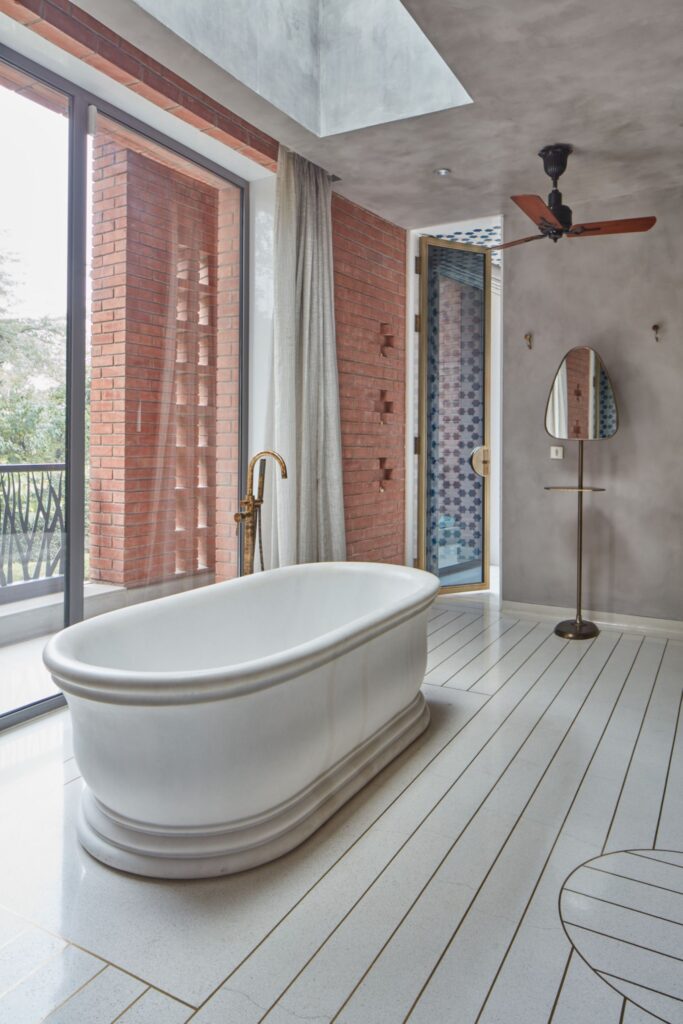
The first step to decluttering your home is determining your style of décor and restoring your home to that vision as already outlined. Next is ensuring that you maintain the oasis of peace and harmony that you have created. This means making sure that no junk accumulates and that you retain the space that is so vital to a minimalist style. And the final step is to make sure that your home is always sparkling clean and fresh and free from health and safety hazards.
Detox Your Home
Your physical and mental health can be affected negatively by clutter. Common problems you may experience are hay fever, asthma, and allergies from dust mites, mould, and pet dander. Cortisol, the stress hormone, will place you in a fight or flight mode. This hormone increases in your blood circulation when you become stressed. Disorganisation reduces the ability to focus and also to relax and make the most of your beautiful home. Avoid clutter and you will avoid insomnia.
Once an area has been decluttered, clean it thoroughly. Make a green cleaner by combining one part vinegar with one part water. Add lemon peel and sprigs of rosemary. Allow it a week to infuse properly then place it in a spray bottle and use it to wipe down all surfaces.
Declutter and detox your home for a healthier, stress-free, and peaceful environment.
How To Style Your Room With Rattan
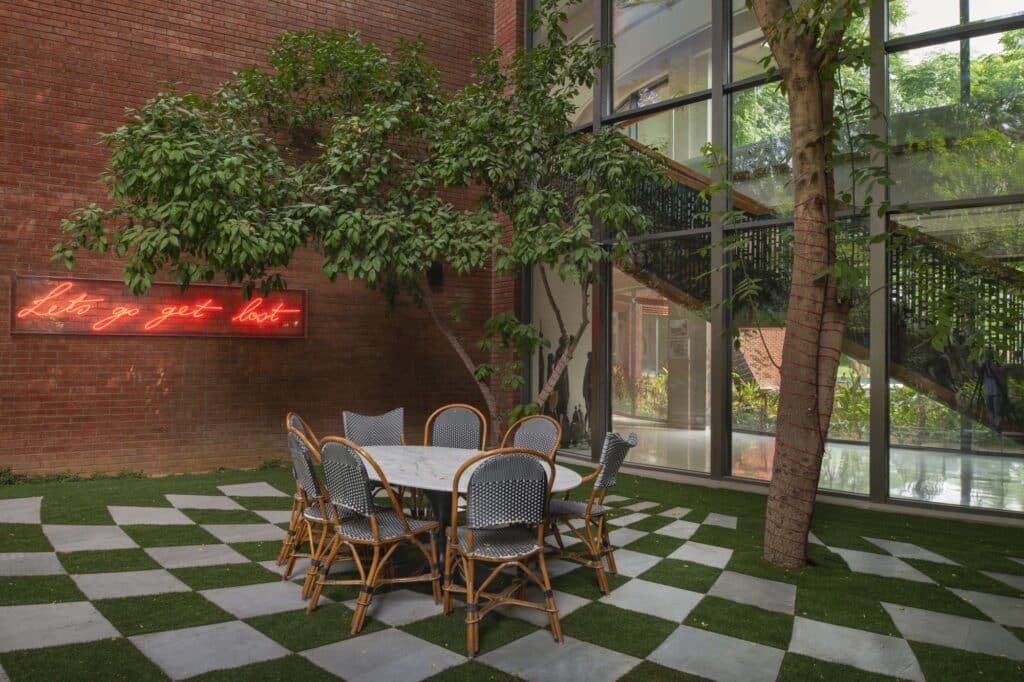
The Bohemian or Boho style of interior design is currently enjoying a lot of attention. It seeks to recreate the outer beauty of nature inside a room or home by using natural colours, patterns, and textures in the interior. Boho is an organic mix of designs that is an expression of free-spiritedness. At the same time, it is an eclectic blend that sees a rattan chair paired with a tribal rug and colourful blanket or two. It is a style where elements are layered and different finishes come together, and echoes biophilic design rather than a hodgepodge of ‘anything goes’.
Following Boho principles when styling a room with rattan is the ideal approach to knowing how much and where to include it. Rattan doesn’t shout its presence, nor does it hide in the shadows. With the right touches, it harmonises with other facets of the underlying design, enhances the organic whole, and adds a note of individuality.
Before exploring ways to incorporate rattan into your overall style, we look at what it is and isn’t.
What Is Rattan?

Natural and woven textures continue to make their mark in home décor. However, most people fail to make the necessary distinctions between cane, rattan, and wicker, believing them to apply to the same material.
It should be understood at the outset that wicker is not a material, but a weaving process using diverse materials. Once the item is complete, it is known as a wicker basket, for example. At the same time, it could also be a rattan basket. Wicker weaves many substances, such as synthetic fibres, palm, raffia, rush, straw, and willow. The method of weaving combines sturdy vertical pieces to form the structure. Narrow, lengthy pieces are interwoven into this for support. The end result can be painted or stained.
Rattan fibres are solid timber vines that are indigenous to the Malay Archipelago and tropical forests in Indonesia. More than 600 species exist. Common uses of rattan are to make baskets, chairs, and tables. However, it is also frequently used in items like shelving units, pendant lamps, and French bistro chairs.
Fibres for rattan nowadays come from a palm called abaca in Southeast Asia. As a natural fibre, rattan is not suitable for outdoor use and exposure to the elements. Rattan’s shape lends itself best to small accessories and certain furniture. It can be combined with a lacquer coffee table and Oriental rug, or Asian screens and chests of drawers, lighting, sisal rugs, and black accents. Rattan is often found in homes at the seaside but goes equally well in formal designs.
Organic Settings
Rattan can be used with multiple styles of design but teams best with organic environments. These styles comprise tropical, organic modern, coastal, and Bohemian. Rattan should be used to complement and support a design, and to add a textural layer, but neither to lead nor dominate it.
The popularity of rattan has not waned in recent years. It adds a muted note to its surroundings and is easily incorporated into most designs, specifically to add texture.
Rattan and a Variety of Finishes
Rattan’s light colouring pairs well with the right finishes. You can team it with dark or light floors and rugs. The rattan can be stained or painted, making it very versatile.
A rattan chair made with flax linen has a simple elegance and the textures contrast nicely. All you need to complete the look is a throw pillow in pinks or blues.
Rattan Layered into the Overall Design
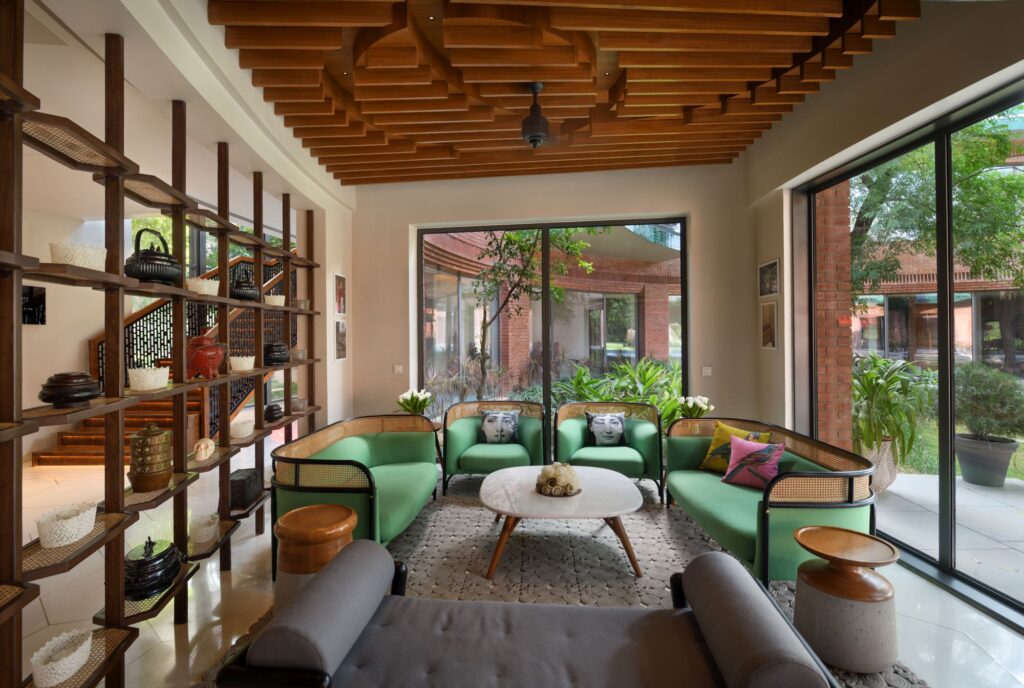
Little touches of rattan can be scattered throughout the home. Done correctly, it requires very little to layer rattan perfectly into your overall design. It is actually very simple to look at the whole environment and find where rattan can be included. Then consider what will highlight or accent it. It could be as small as a toy basket with a navy blue ribbon wound around the handle. Rattan should not overpower the chosen design.
In the dining room, rattan placemats with a complementary turquoise table cloth will add vibrancy without overwhelming the décor. Food trays made from rattan can have matching cloths. These can also be used in the living room on the main table to place keys and remotes. The colour of the cloth will vary accordingly. Display boxes on shelves in the living room, study, or bedroom is a small step toward bringing the rattan component into a room.
Kitchenware encased in rattan and a rattan pot plant holder with a bright green plant is uplifting. In terms of adding bits of colour to rattan items, botanical or floral materials will complement the feel of nature indoors. Earthy colours teamed with rattan provide a balanced note. Opt for greens, greys, sage, and beige. Navy blue will provide a stronger but more serious contrast.
Different Styles Paired with Rattan
It has already been mentioned that a Bohemian style is a perfect style into which rattan can be introduced. Another great style is shabby-chic. Traditional and formal areas will benefit from the whimsy rattan brings. Include an abundance of indoor plants, floral prints, and natural wood items that will soften a sterner room. Also, consider metallic colours in small amounts and silky mid-century furniture.
Using Caned Rattan Furniture to Enhance Style
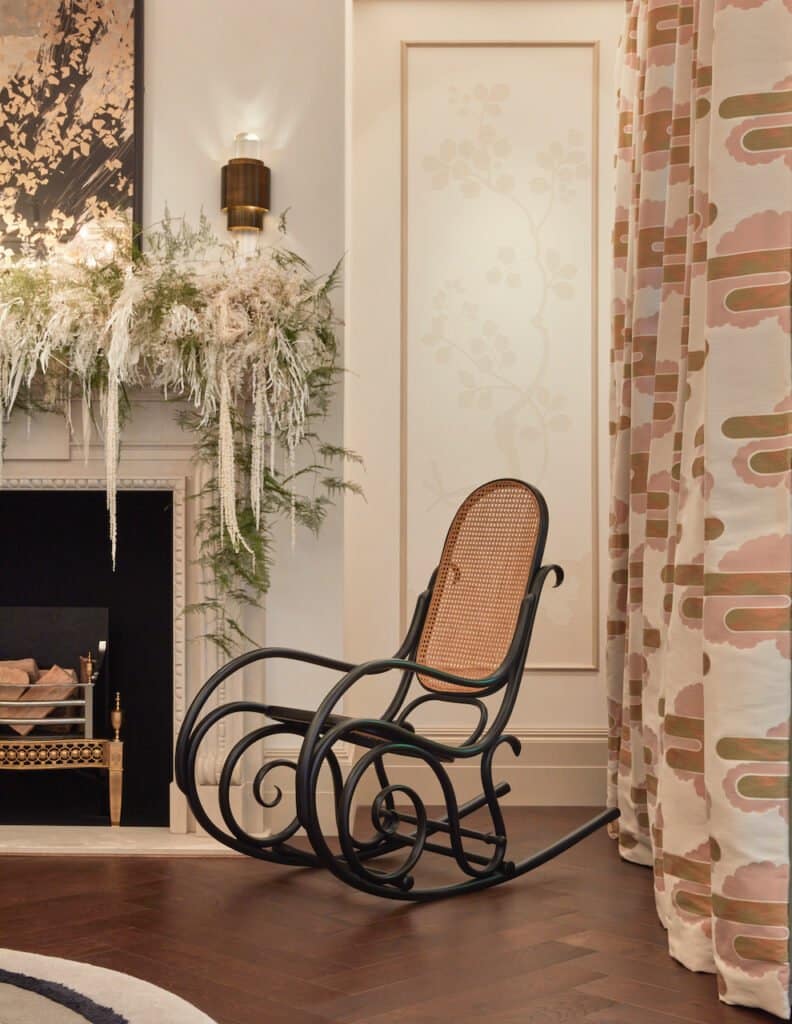
Cane furniture is predominantly made from the outer bark of rattan fibre. This material has an open weave in multiple directions. Cane furniture recalls an atmosphere of the wind gently blowing and softly lifting the curtains, a feeling of freshness and light. Boost this style with caned headboards, chairs, and storage containers (e.g., an ottoman).
Rattan Storage Containers
There is a size and shape rattan basket to fit any space. From a wash basket to a toy holder, there is no shortage of options. Use bigger containers to store linen and blankets. There is no reason these baskets should not be useful as well as beautiful.
Paint Or Stain Rattan
Rattan can be painted or stained in any colour that is complementary to the overall design. This can make items of rattan furniture look brand new. Rattan is often painted white for an elegant appearance.
Start with one room at a time. Consider your style of décor and determine the role rattan can play.
Modern Vastu Interior Design Trends
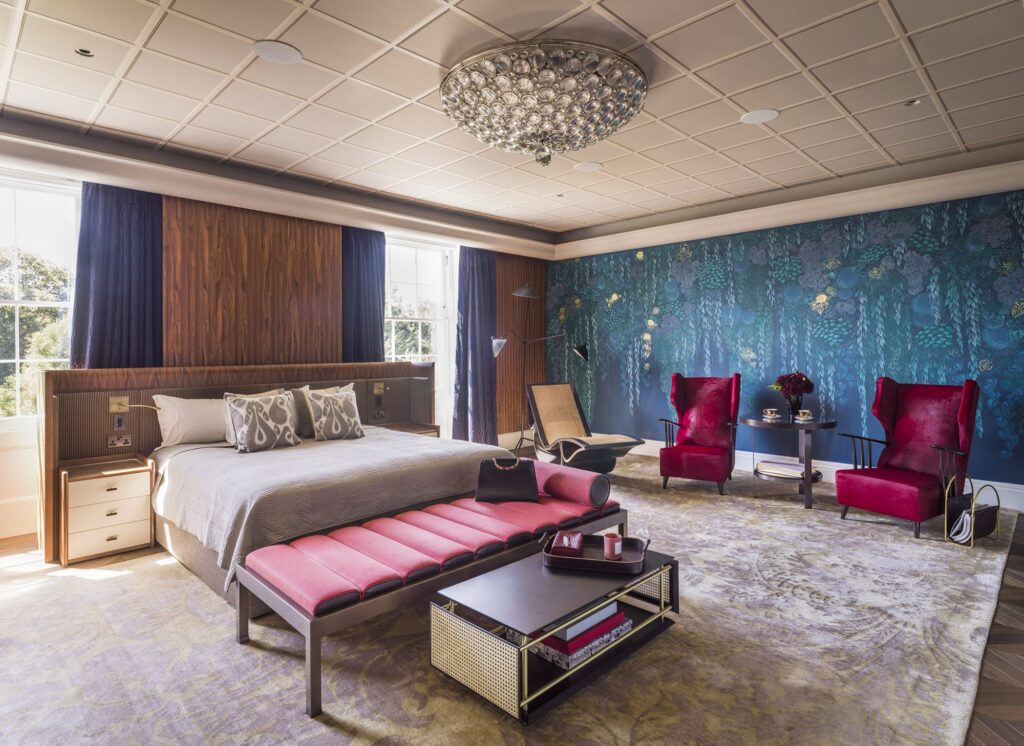
Vastu Shastra has an ancient history that was recorded in the Vedas during the period of 1500-1000 BC. While not many people outside of India have heard of Vastu, those who have known it see it as an architectural and spiritual guideline. Its origin is attributed to Vishwakarma, one of the gods in the 33 billion deities that exist in the Hindu pantheon of gods and goddesses. Vishwakarma is known as the divine architect who is credited with creating the world and teaching all crafts to mankind. Even today, some believers do prescribed rituals before construction work can be carried out.
Most of the earlier writings between the sixth century BC and the sixth century AD have been lost or are in a fragmentary state. Our modern knowledge of Vastu Shastra is a composite of what remains in the fragments that have survived, the Veda, traditions handed down orally, and what can be observed in examples of Vastu architecture. These beliefs are thought to have originated, developed, and been extended in the period 6000 BC and 3000 BC, influencing Hindu architecture.
We take a look at the principles that have been gleaned from these sources and how they can be applied to the interior design of modern homes.
The Principles of Vastu Shastra
Vastu Shastra did not only apply to Hindu architecture but was valid for any form of construction including a town, city, road, temple, and house as well as for plots to build on. Factors that guided decisions were based on how to maximise the potential of a piece of land and the placement of a structure on it, wind direction, the position of the moon, the heat and light from the sun, and the planet’s magnetic field.
The five key elements needed to be in harmony. These are air, fire, water, earth, and space. Photos of modern-day interior design using Vastu principles demonstrate this with plenty of space between furniture and other objects, wide internal walking areas, and space between the house and the plot boundaries. The five senses, seeing, hearing, smelling, tasting, and touch should also interact harmoniously.
The energy field, which surrounds every home and is specific to it, affects those that live there. Vastu design principles ensure the attraction of positive energy and abundance. There are some similarities between Vastu and feng shui, which seek to align the home with its natural surroundings.
We cannot apply all of the Vastu Shastra principles to contemporary homes. For example, one of the requirements is to have a courtyard in the exact centre of the house. Front doors must face a certain direction. We cannot break down our houses and recreate them correctly. However, it is possible to incorporate certain elements into how we carry out interior design. Let us see what we can do to improve the energies in our homes and hopefully increase our wealth, balance, and happiness.
The Front Door
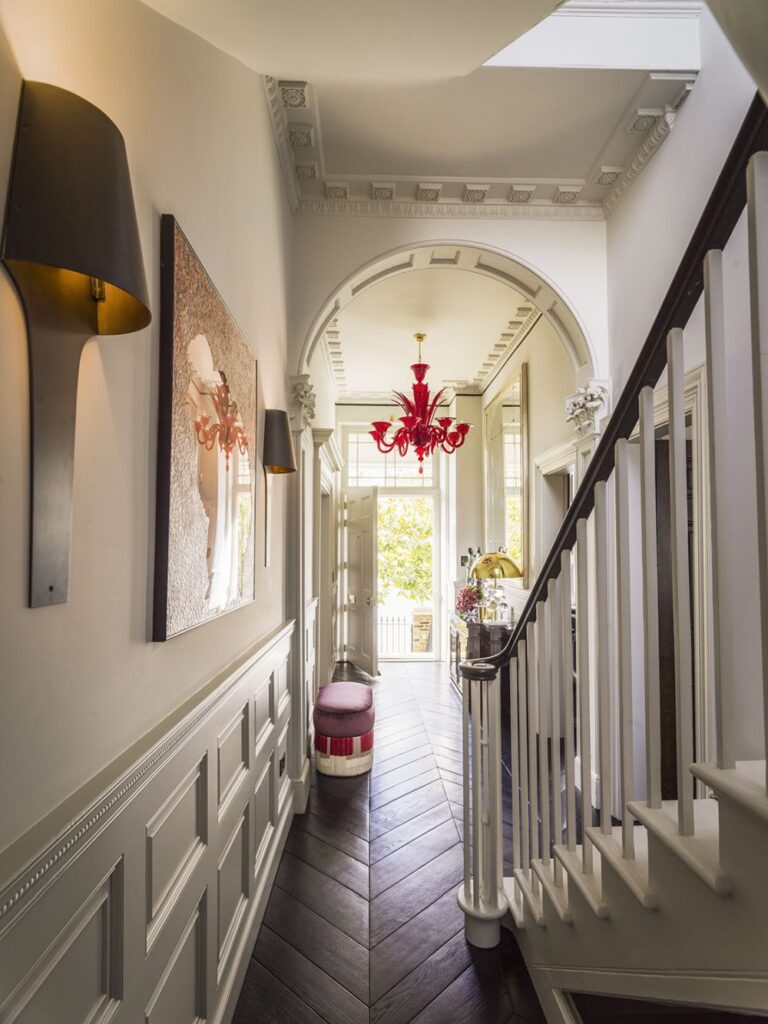
The front door plays an especially important role in Vastu Shastra. It is through the front door that energies enter the home, along with all else we allow to come in. When you exit the front door, you should ideally be facing the north, the east, or the northeast. Many properties today are north facing.
The front door should open clockwise. It must be much taller than any of the other doors in the house. No bathroom must be positioned close to this door.
If your home doesn’t comply, don’t worry; there are other things that can be done.
Your front door should be made of the best quality wood available and be more attractive than your other doors. It must not be painted black. There should be no water elements, such as fountains, in the direction of the door. Other items that must not be placed outside the front door are shoe racks, figurines, animal statues, and dustbins.
The entrance must have bright lighting; this applies to all lighting inside too. You can use stunning nameplates to decorate the door. A toran, which is similar to a wall hanging and is decorated with auspicious symbols, can be hung outside the front door.
Furniture
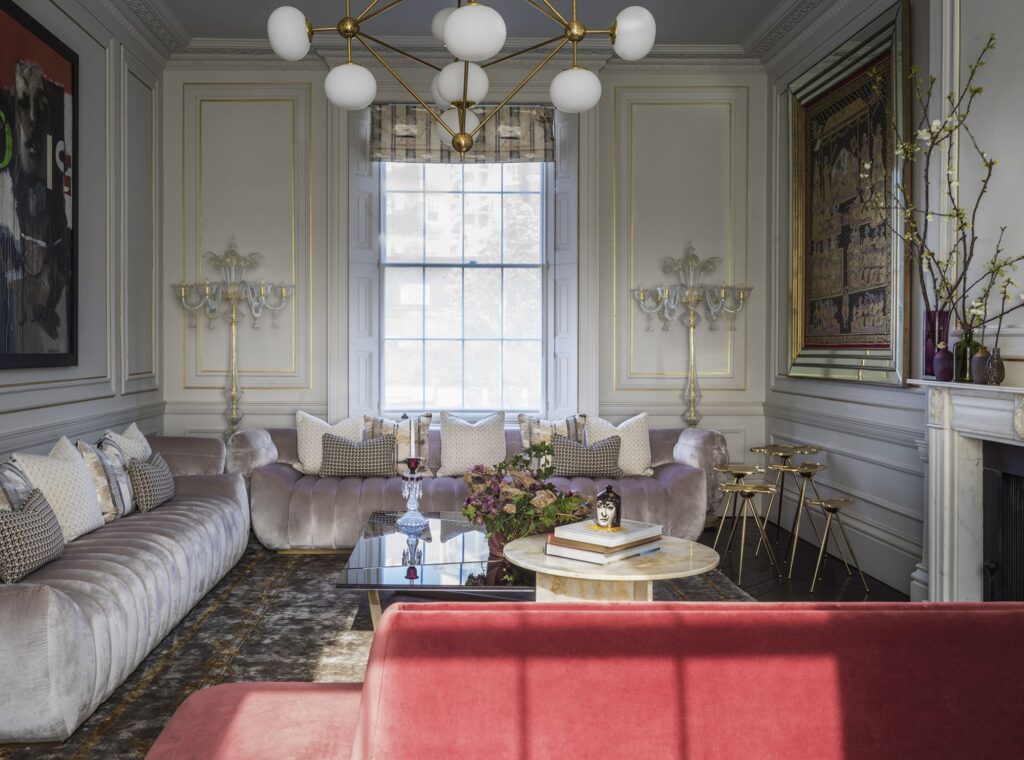
The living room where you receive guests should face in the same direction as the front door. If you have heavy furniture in the living room, this must be placed in the west or southwest. Mirrors should be situated on the northern wall of this room. Position appliances and electronic items in the southeast in any room. Don’t situate big pot plants in the northeast.
If your bedroom faces southwest, then it is perfectly placed for wealth and good health. The bed must be situated in the southwest, and when you sleep, your head must face west. No mirror or television must be situated in front of the bed while you are sleeping as it will capture your reflection. If you fail to comply, you can expect marital disharmony and discord in the family. Don’t use rooms in the northeast or southeast as bedrooms to avoid problems with your health. Wardrobes must face southwest.
Once again, you may have no control over the direction a room faces. But what you can do is use earthy colours to paint the walls to create positive energy. Never use black paint. If you want to avoid high, unstable emotions, avoid anything in the bedroom that is watery, for example, a fountain or a painting of nature that contains water elements. Make use of fragrant oils and mood lighting for a calm state.
All walls should be painted cream, blue, pink, or green, or in earthy colours.
Items That Will Attract Good Fortune to the Home
A crystal or wooden tortoise symbolises protection with its hard shell. Wooden tortoises should be placed either in the east or southeast. For crystal tortoises, the northwest or southwest provide the best placement. They will bring you fame and fortune.
An Arowana fish is used for attracting good luck and money. Place it in the east or northeast.
A Shree Chakra in the east is more than a decoration. It entices wealth. The Shree Chakra is a yantra, a mystical diagram, with nine triangles. It is possible to get it in a 2D form for hanging, or a 3D model, which is more powerful.
Apply Vastu to your home by applying these guidelines and use matching textures and colours in your décor.
How To Style And Use Your NFT At Home

Non-fungible tokens (NFTs) have hit the headlines in recent months, but millions of people remain unfamiliar with what an NFT actually is and how it can be used. If the world of NFTs is still a mystery to you or you’ve never heard of incorporating NFTs into your interior design, you’re certainly not alone, but help is at hand. Here, we take a closer look at how NFTs are changing the way we look at design and how you can use NFTs to enhance your own home.
What Are NFTs?
A non-fungible token is actually a form of financial security that confirms your ownership of a digital asset. Until NFTs were introduced, purchasing digital assets was a risky business. After all, there’s nothing stopping other users from right-clicking on a digital image or video and downloading it to their own hard drive.
Now that NFTs are available, purchasing a digital asset becomes more worthwhile, as your ownership is recorded in the blockchain. The blockchain is essentially a distributed ledger that records information. Additional blocks are added to the chain when there’s new information (or transactions) to record. While ownership of an NFT can be transferred by adding another entry to the blockchain, previous entries cannot be deleted. This makes it easy to authenticate your ownership of a digital asset.
What Can Be Sold as an NFT?
When you purchase an NFT, you’re effectively buying the right to assert yourself as the owner of a digital item on the blockchain. However, a wide array of items can be sold in the form of a non-fungible token. Clothes, artwork, furniture and even houses have been sold as NFTs in recent times, with Beeple’s artwork entitled, ‘Everydays – The First 5000 Days’, selling for a staggering $69.3 million dollars at Christies in 2021.
Of course, buying an NFT doesn’t mean that you receive a physical item – quite the opposite. While some NFTs may include physical assets, the majority of non-fungible tokens are related solely to digital files. If it seems strange that a virtual chair or digital painting can sell for as much (or more) than its physical counterparts, you’re beginning to understand the new and exciting world of NFTs.
How Can NFTs Be Used in Interior Design?
As so many types of NFTs consist of artwork, decoration and furniture, it’s no surprise that non-fungible tokens are having a revolutionary impact on interior design. Despite the increasing trend of releasing NFTs amongst creators, many people are still unsure how to use and style their new decorative assets. For inspiration, take a look at these four ways to use NFTs to enhance your surroundings:
Digital Displays
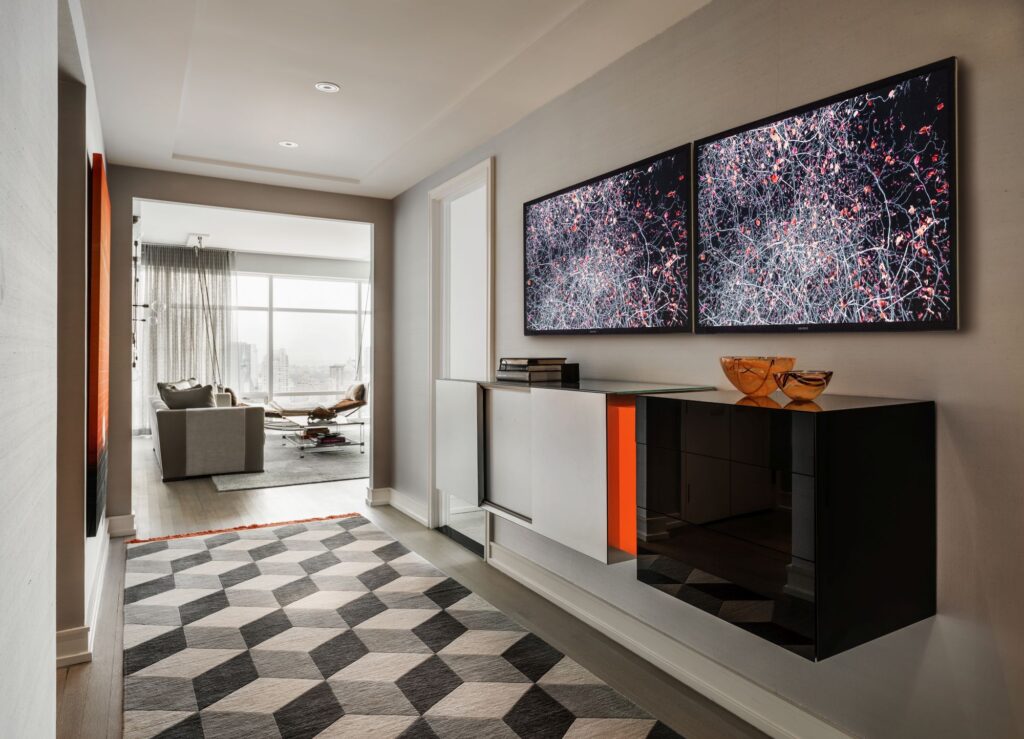
Buying a digital asset gives you the opportunity to display the piece in your home in its original digital format. From digital frames that showcase your latest NFT artwork to projectors that generate life-size images of your NFTs for an immersive experience, there are plenty of innovative ways to display digital assets around your home in their original format.
A dedicated NFT frame is designed to show off digital artwork at its finest but there are also a lot of user-friendly features to look out for. Using motion sensors to determine when people are nearby, an NFT frame can even recognise when to start displaying pieces, for example, or show various artwork from your NFT collection on a loop.
Physical Copies
Being able to render a physical version of your digital NFT gives you added scope when it comes to using and styling the item around your home. If you purchase an NFT of a chair, for example, having a physical version created allows you to incorporate the piece into your interior design and integrate it into your day-to-day life. Adding physical functionality to the digital form, this is an exciting way to make your NFT tangible and maximise its impact.
When creators release NFTs, they sometimes offer buyers added bonuses, such as access to a new collection or a physical copy of their non-fungible token. If so, you’ll receive a physical version of the digital asset you purchase, which ensures you’re able to enjoy a new piece in various formats throughout your home.
Showcase NFTs via the Metaverse
The ‘metaverse’ is still tricky to define but you can think of it as a blend of virtual reality, augmented reality and real-life. Commonly hailed as the ‘future of the internet’, the metaverse empowers people to live digitally, as well as physically, so where better to use your NFTs to spruce up your environment?
If you’re active in the metaverse, you’ll notice than NFTs are becoming increasingly coveted within this world. In fact, designers and major brands, like Adidas, are releasing new product ranges for users to wear or enjoy within the metaverse and you can use your own NFTs in a similar way.
Print Videos
If printing videos sounds like an oxymoron, prepare to be surprised! In a new twist on NFT displays, adventurous innovators are printing videos and turning them into permanent design objects. When you add printed video to your interior design, you can style it in the same way as printed images or regular artwork. From custom frames and bespoke installations, printed video turns moving images into must-have artwork in your home or workspace.
Alternatively, print a still image from your NFT video and incorporate a QR code into the design or frame. You can style the piece as artwork in your home, with the QR code providing instant access to the NFT video in digital format.
Are You Ready for NFT Interior Design?
Although NFTs are proving to be wildly popular, we’re still at the inception of this exciting new technology. As more creators release NFTs and interior designers become more accustomed to integrating non-fungible tokens into their work, we’ll see more and more people adorning their spaces with these innovative pieces. If you want to get ahead of the curve and set the trend, begin exploring the world of NFTs now and discover how interiors can be elevated by blending digital and real worlds.


